
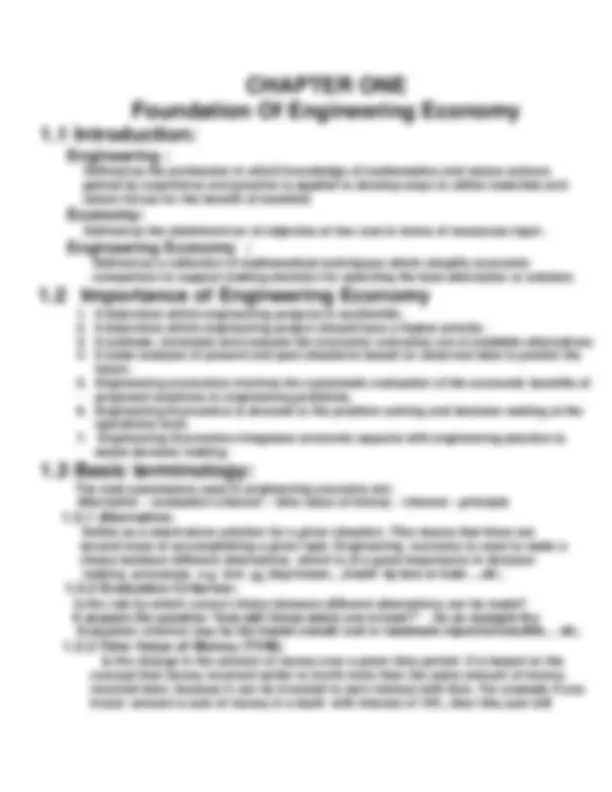
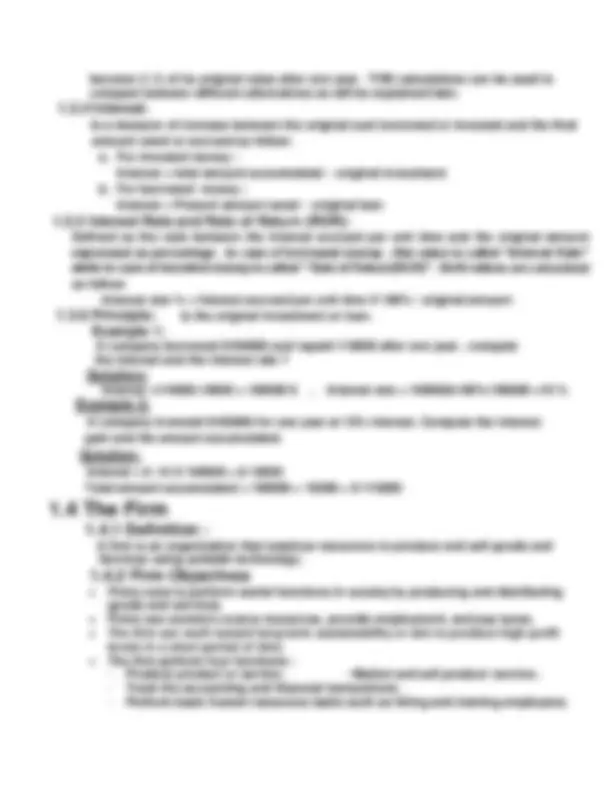
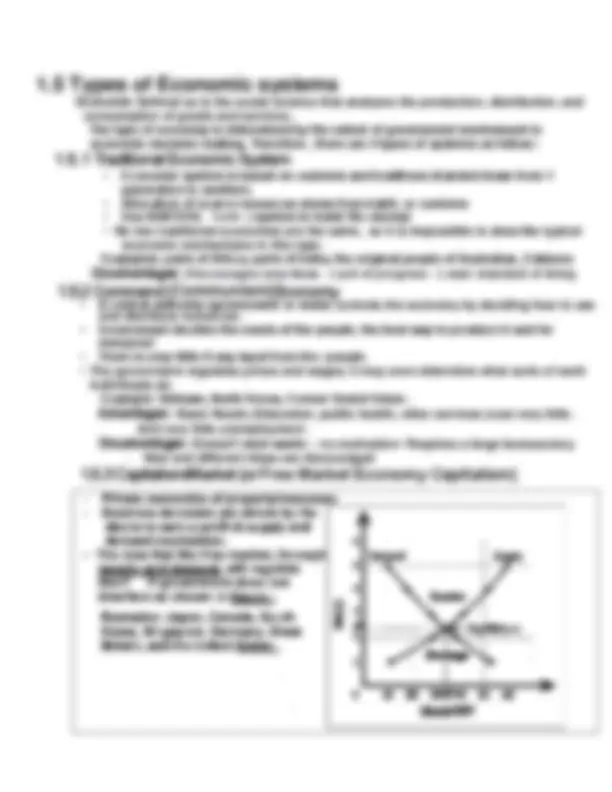
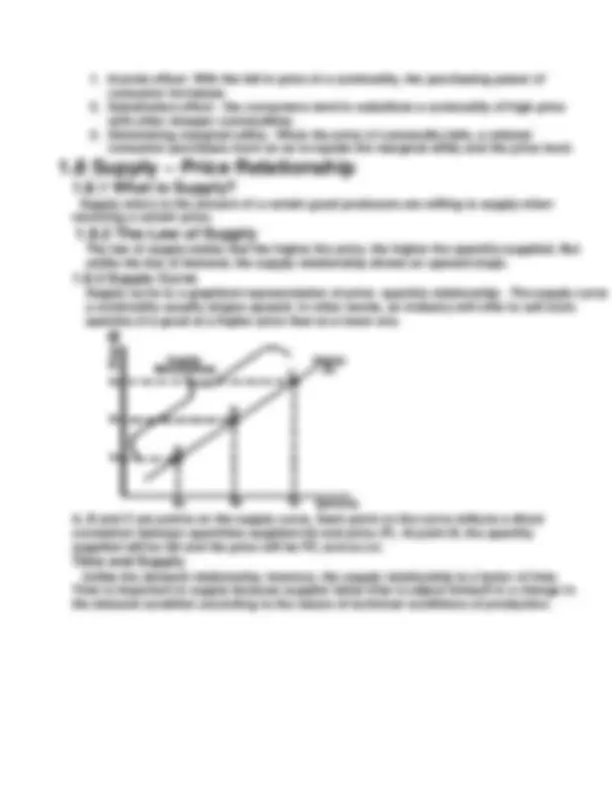
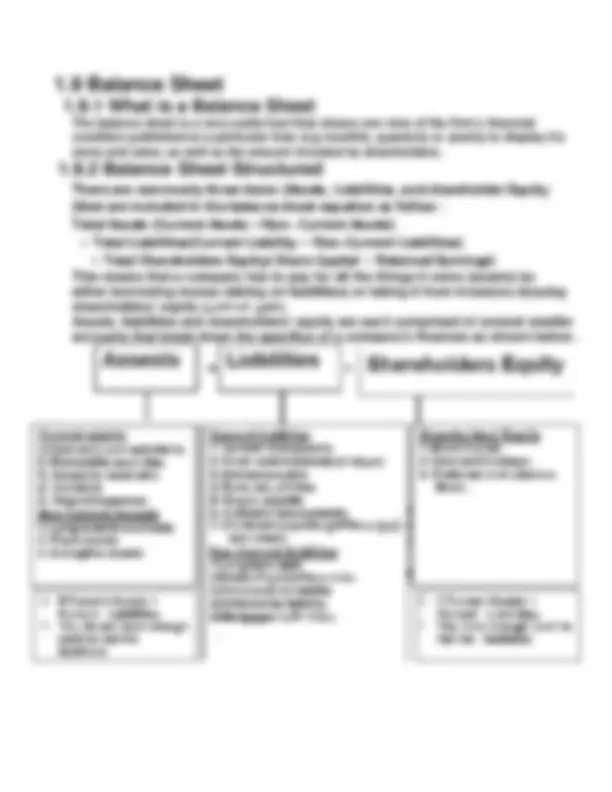
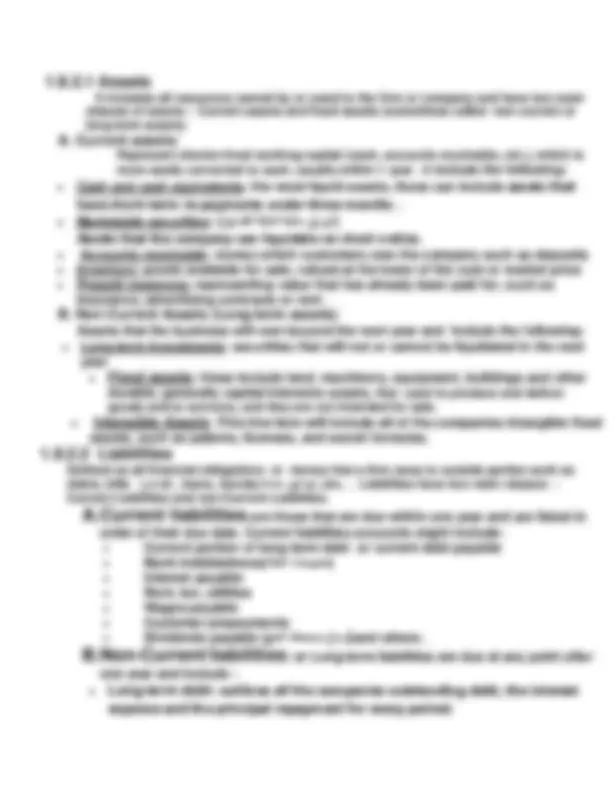
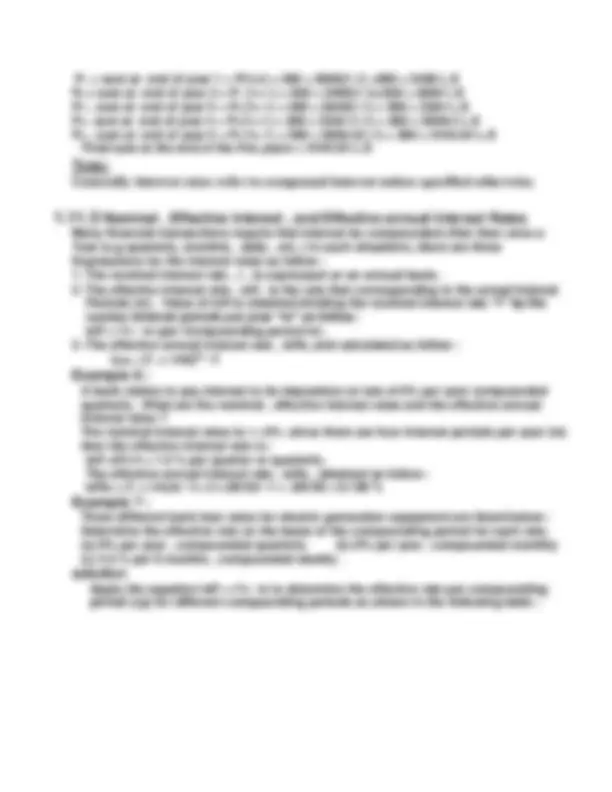
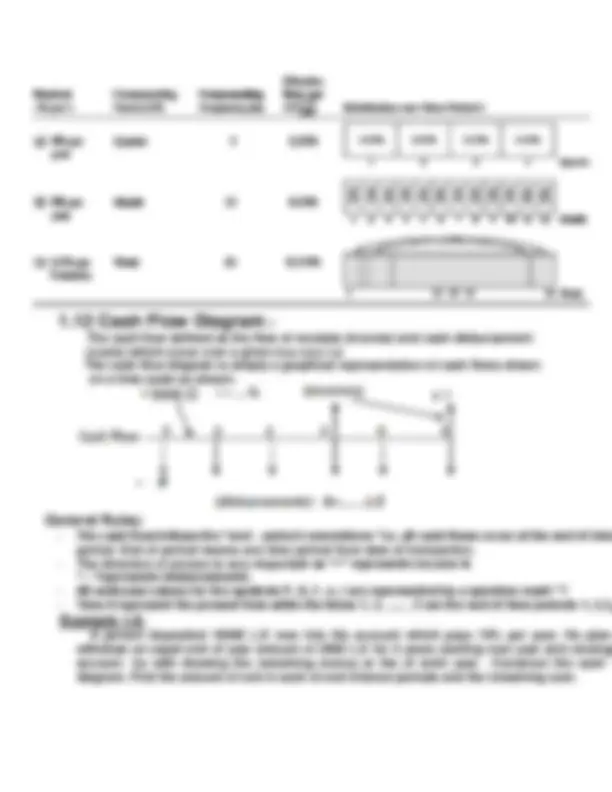
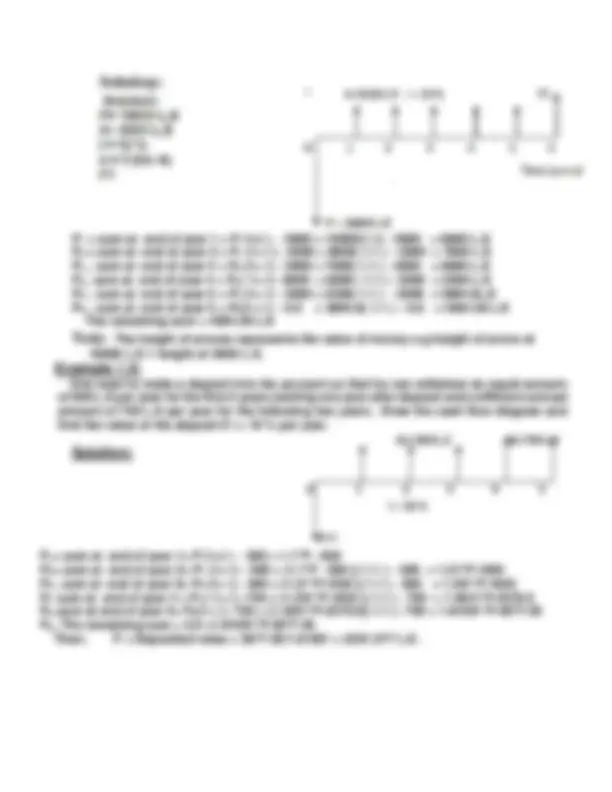
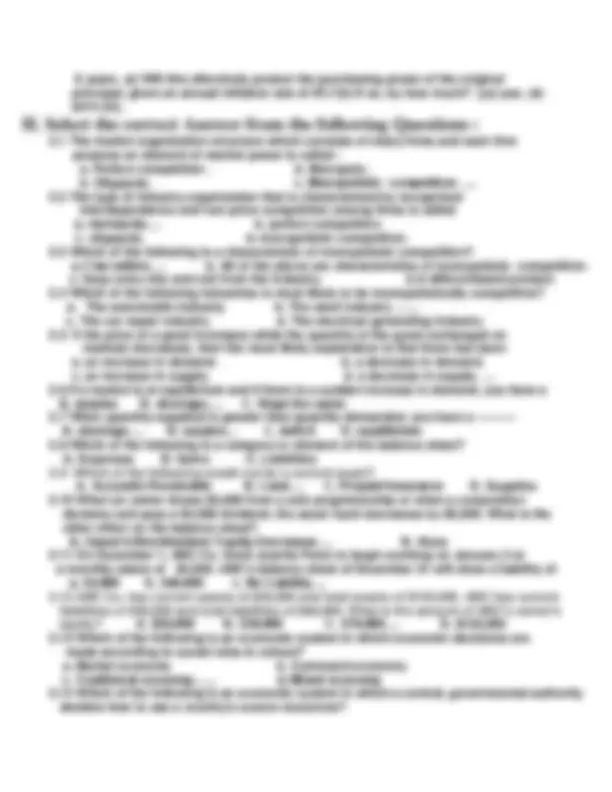
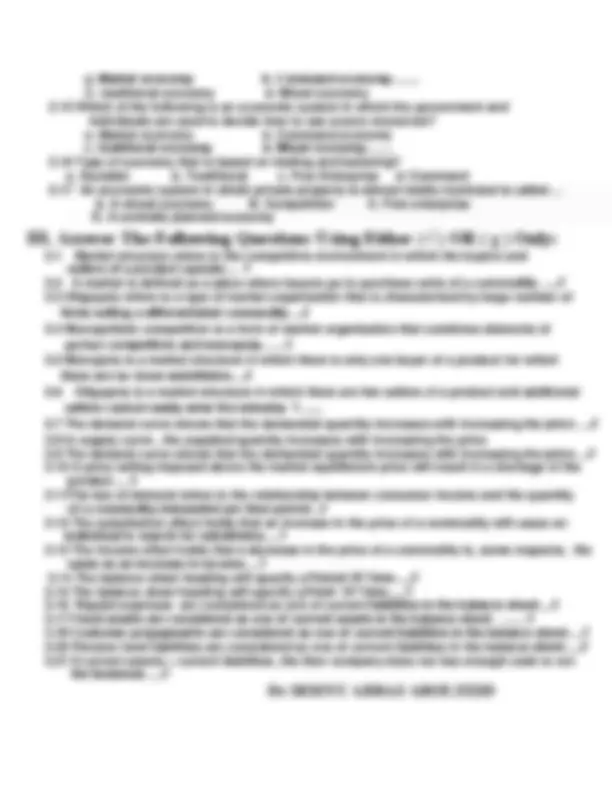
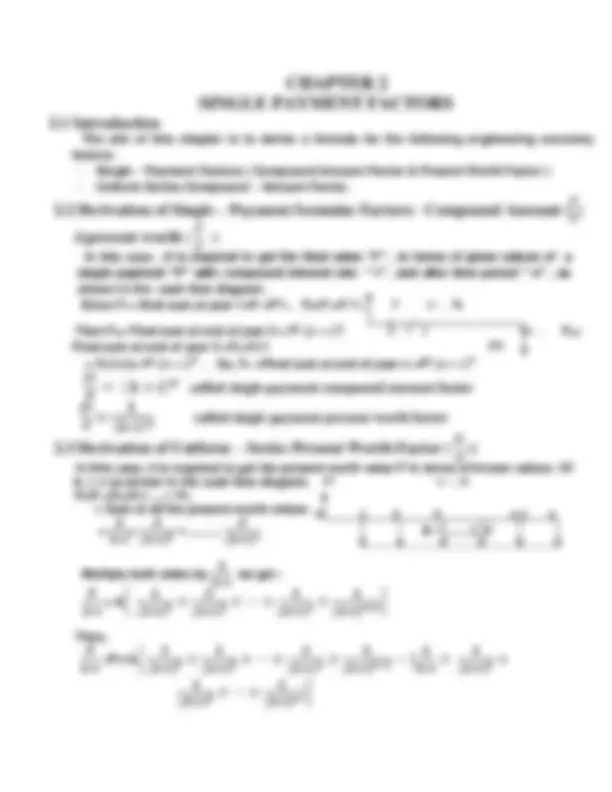
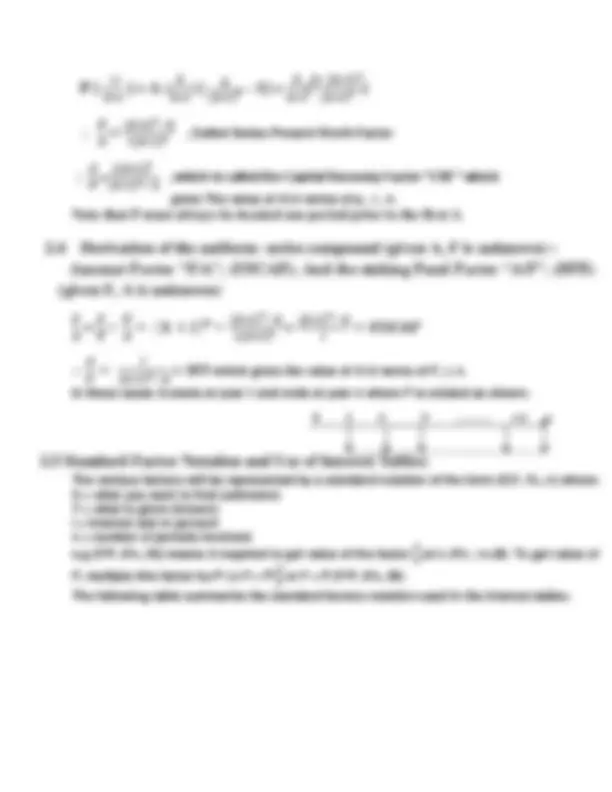
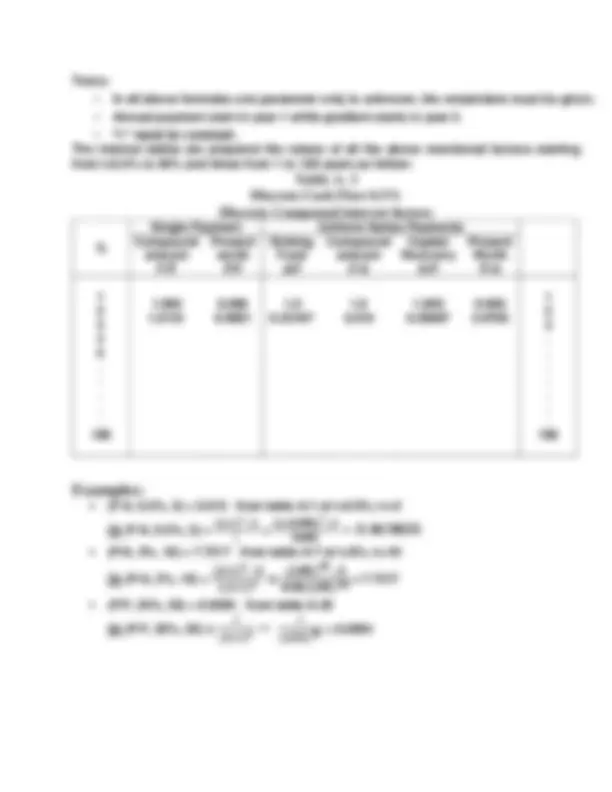
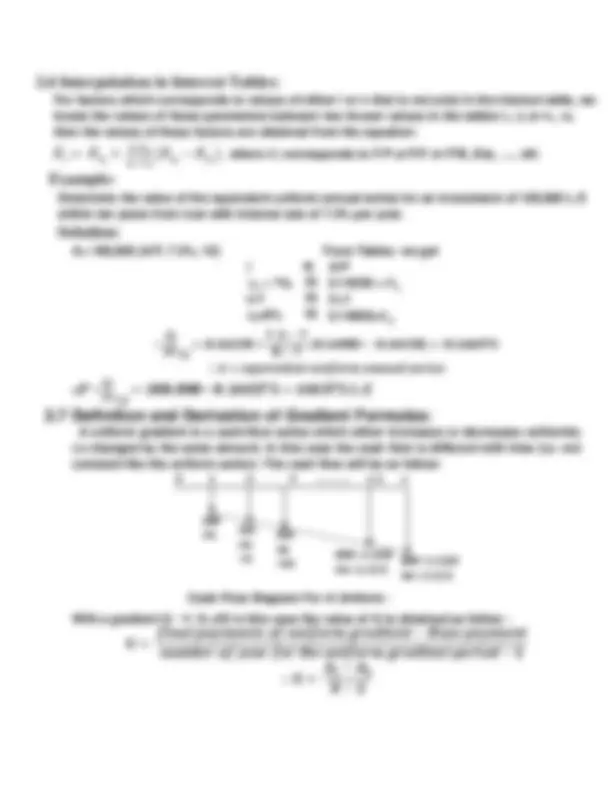
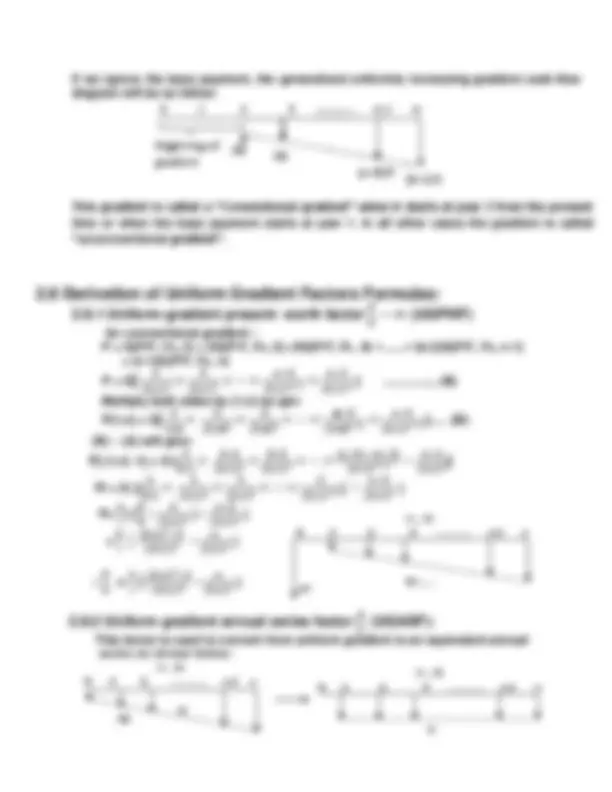
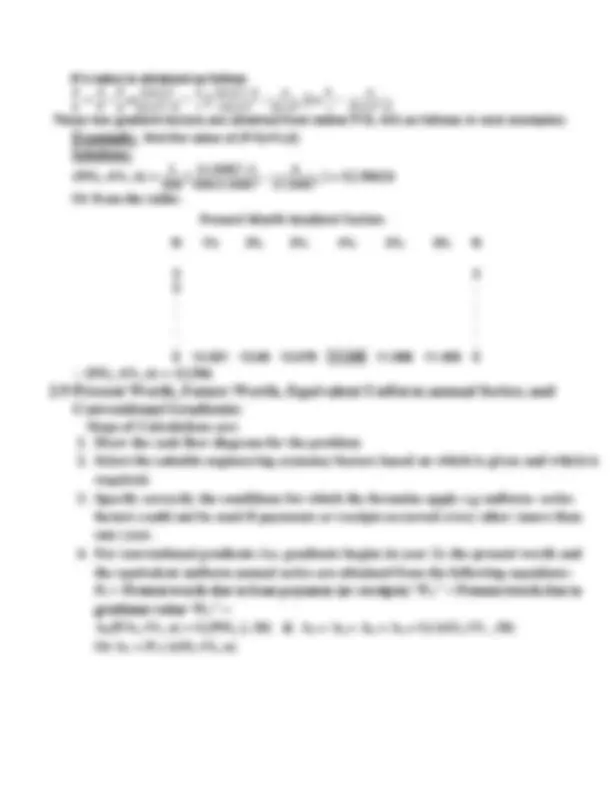
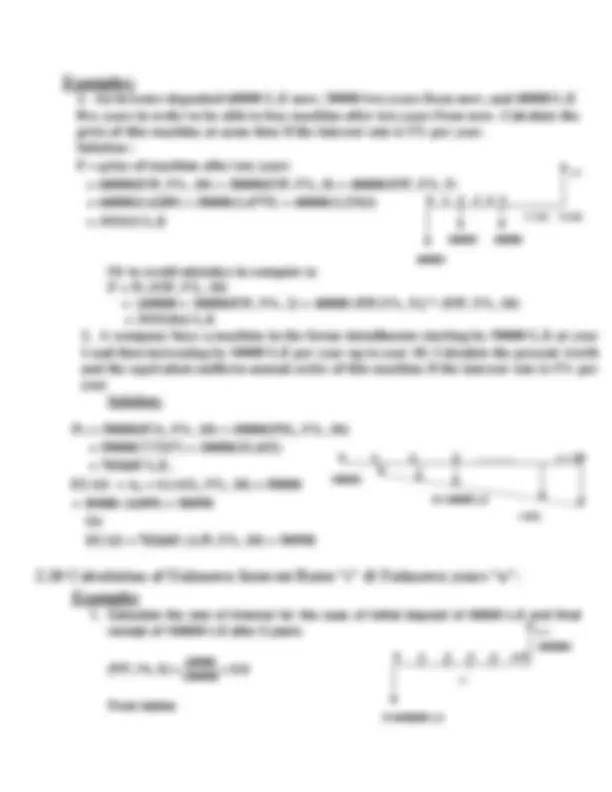
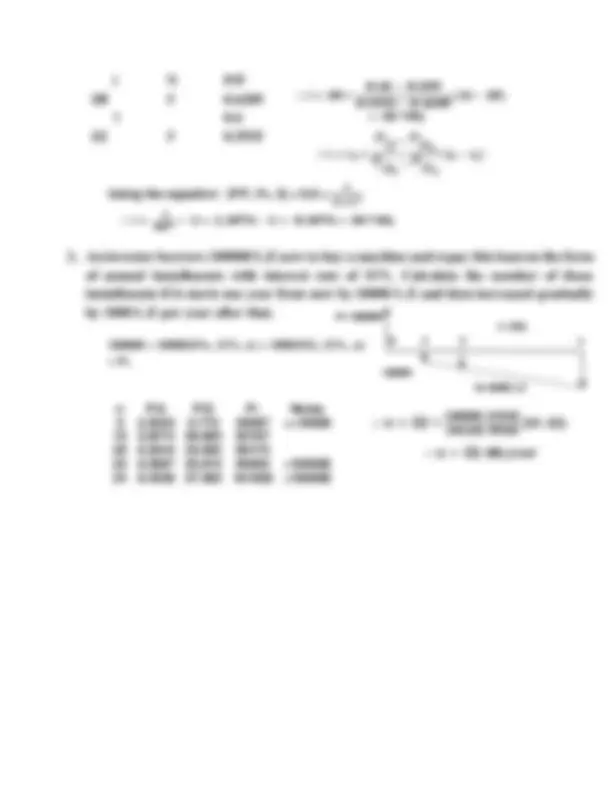
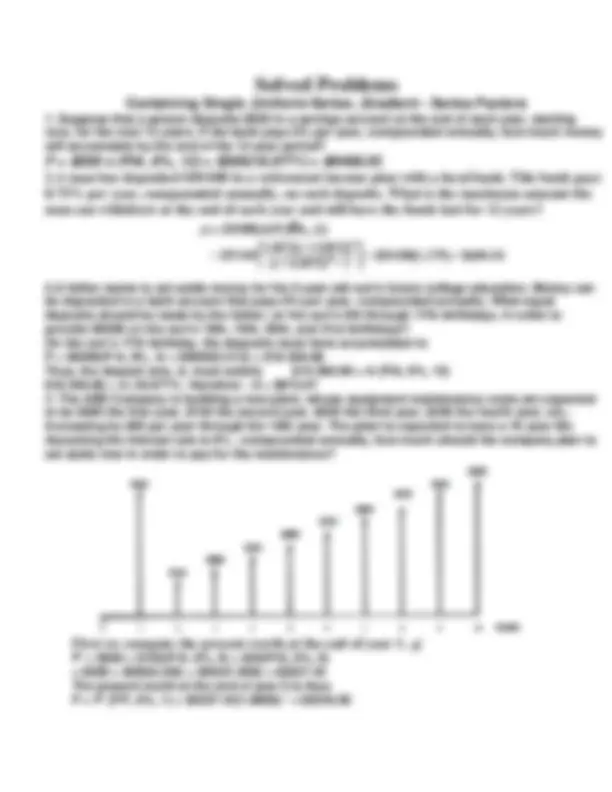
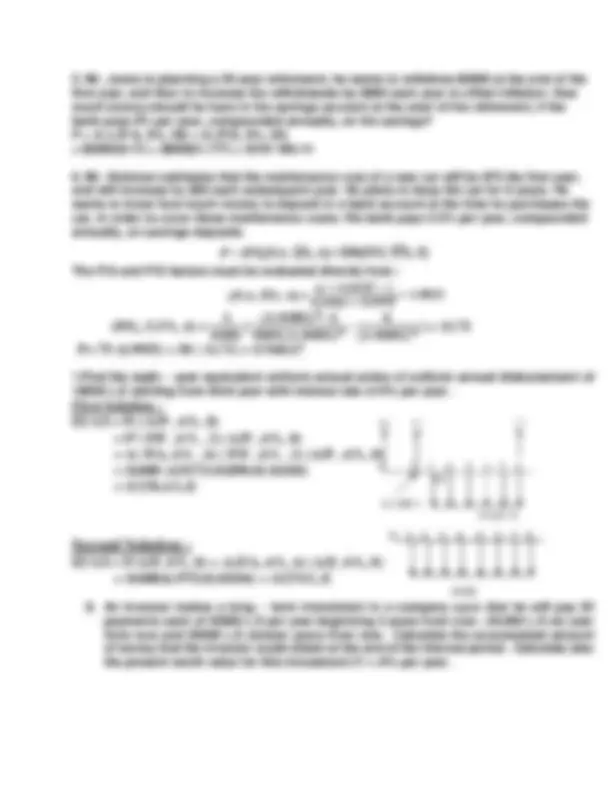
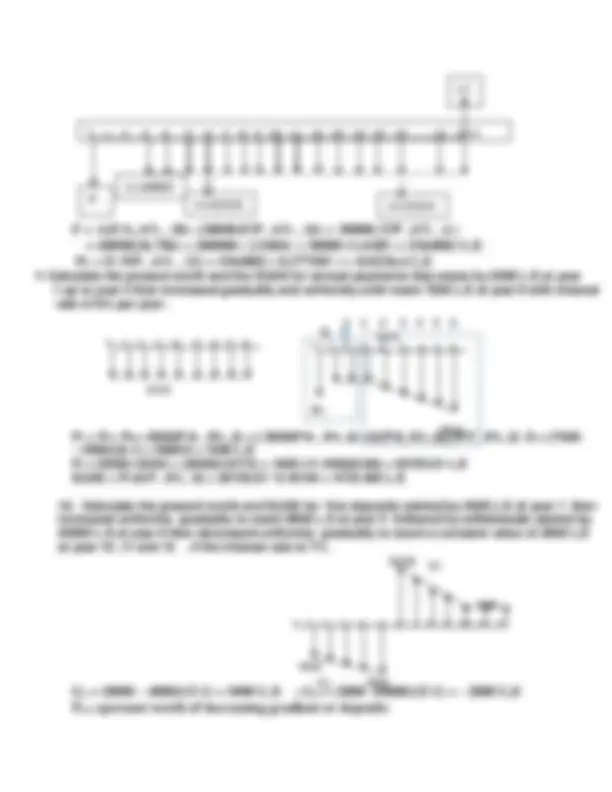
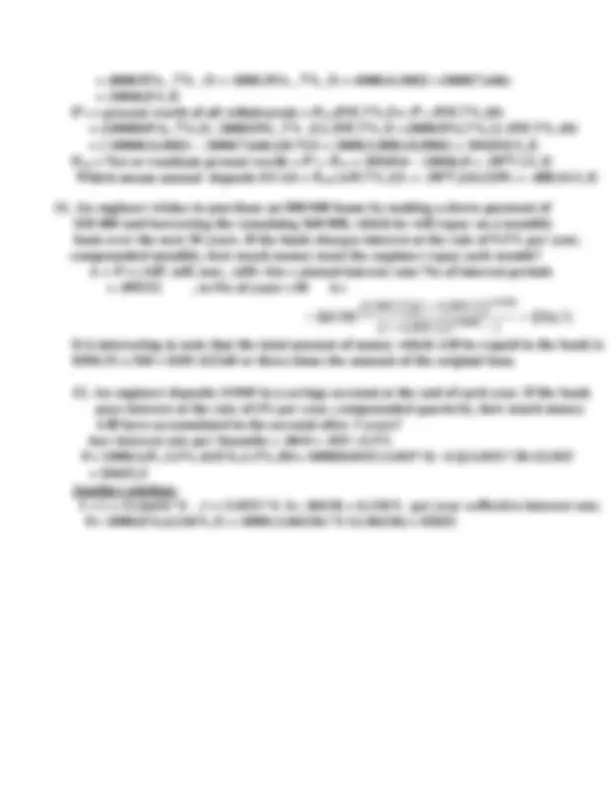
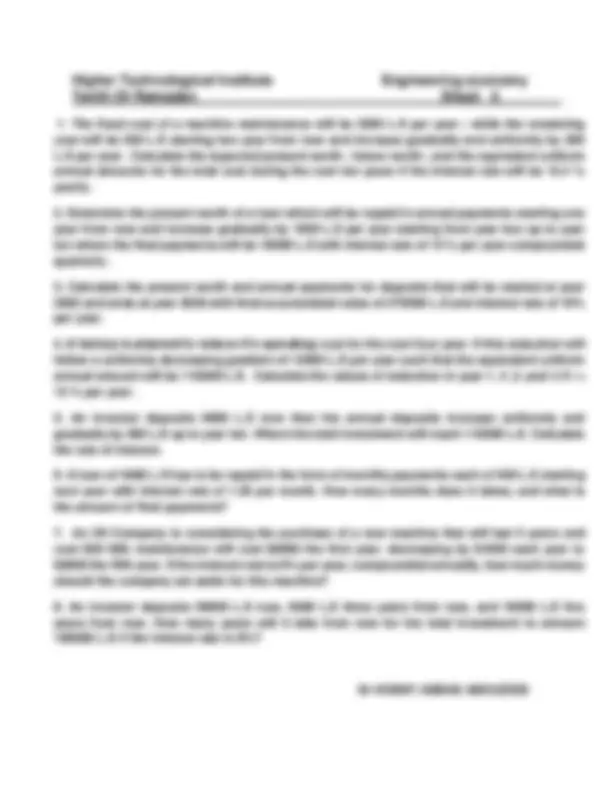
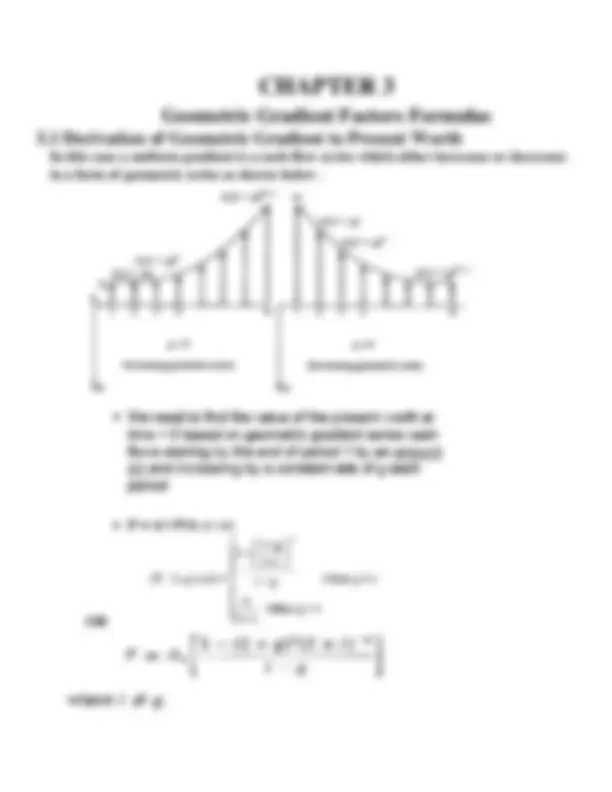
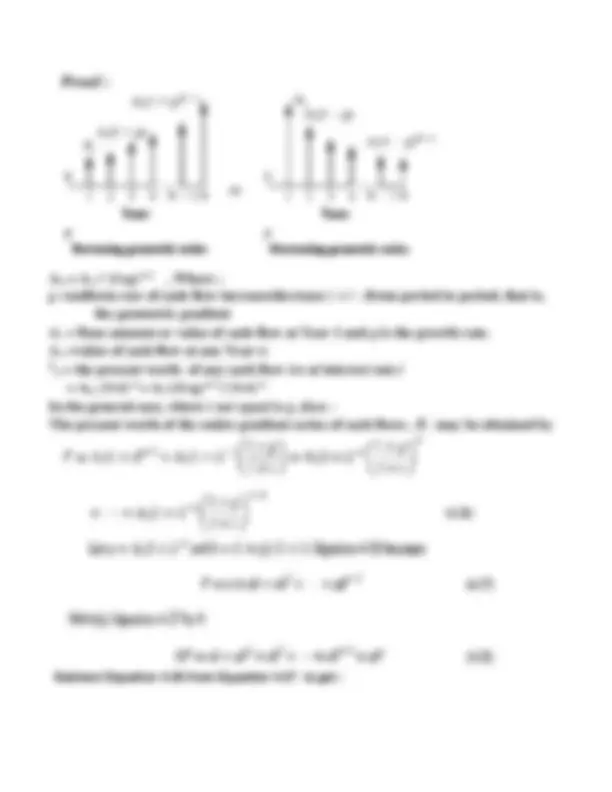
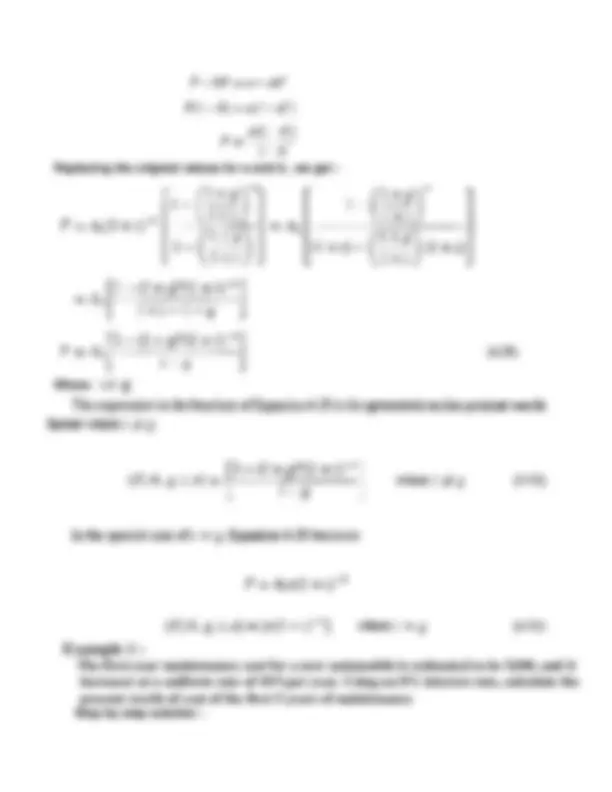
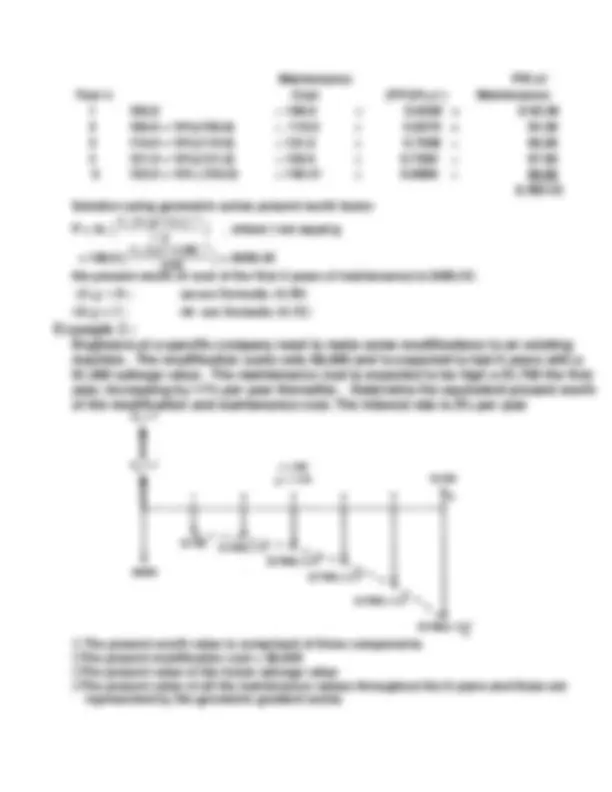
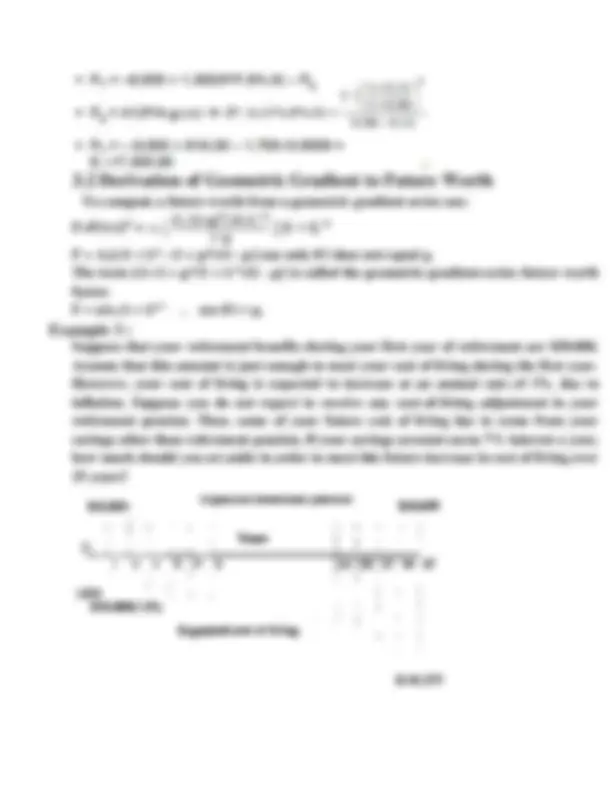
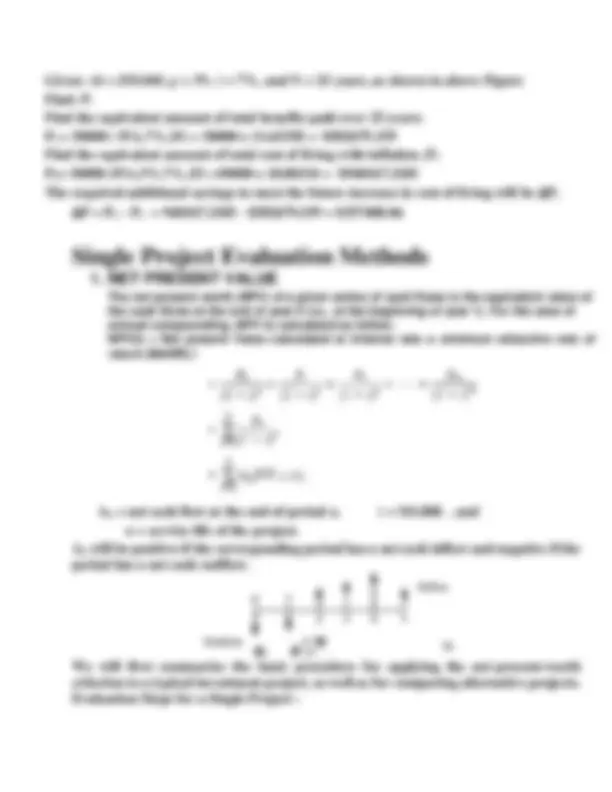
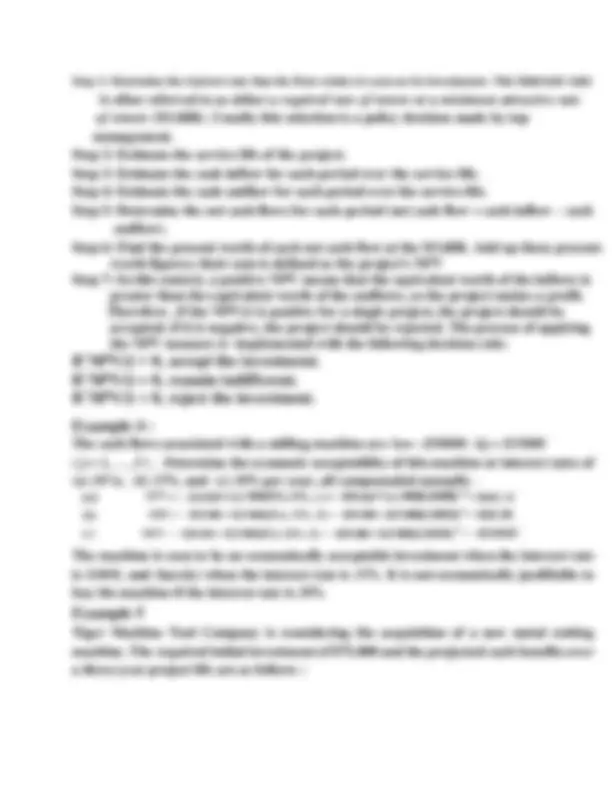
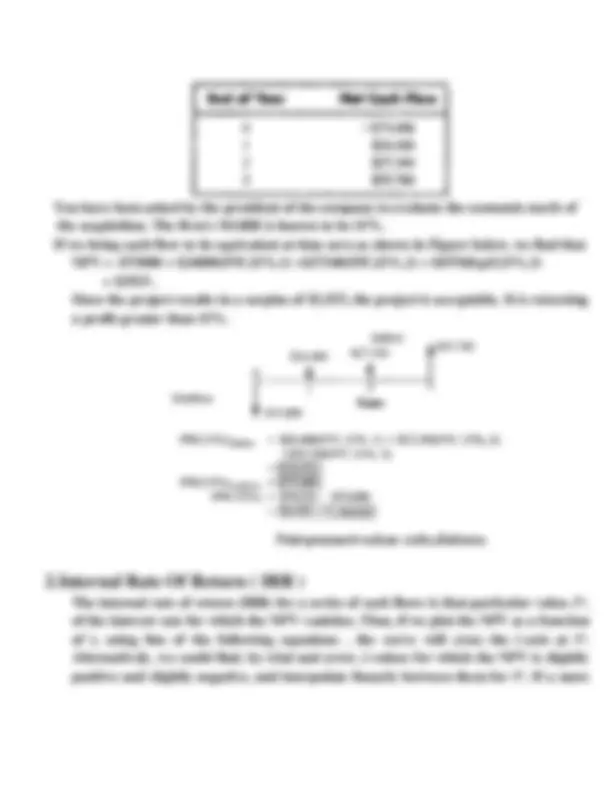
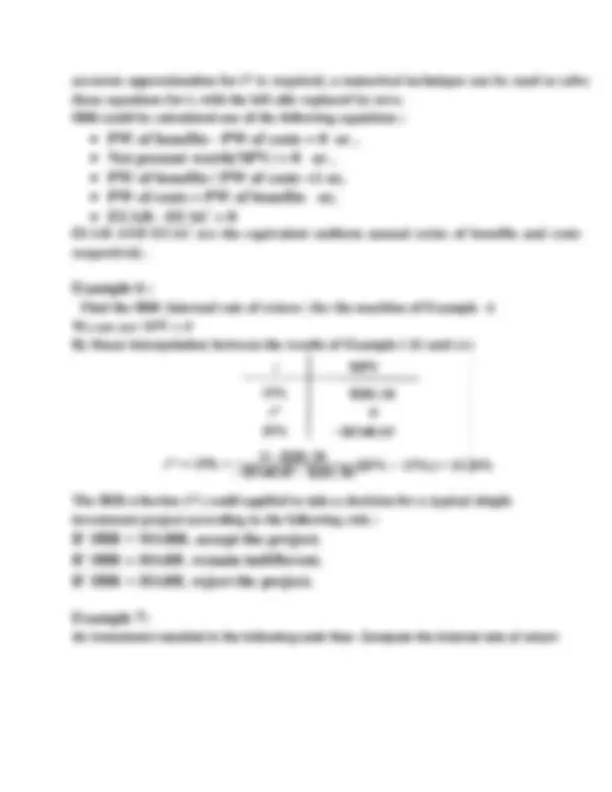
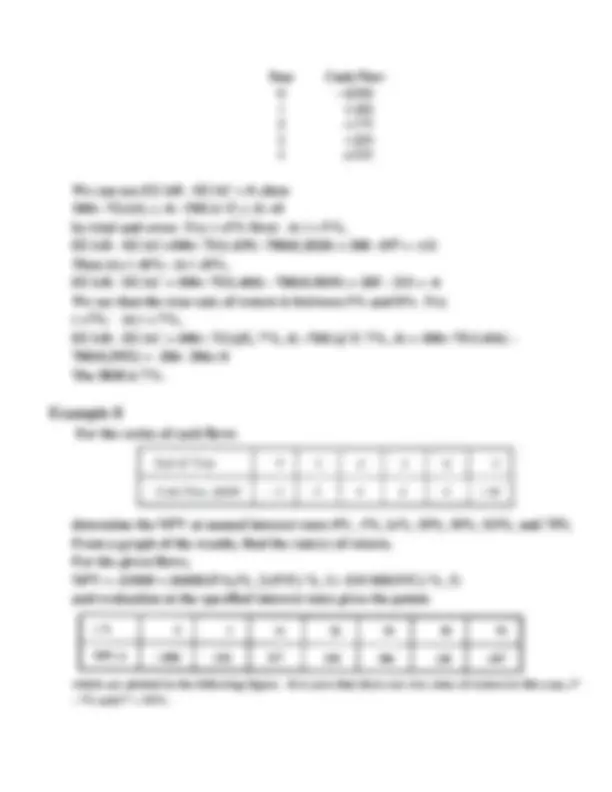
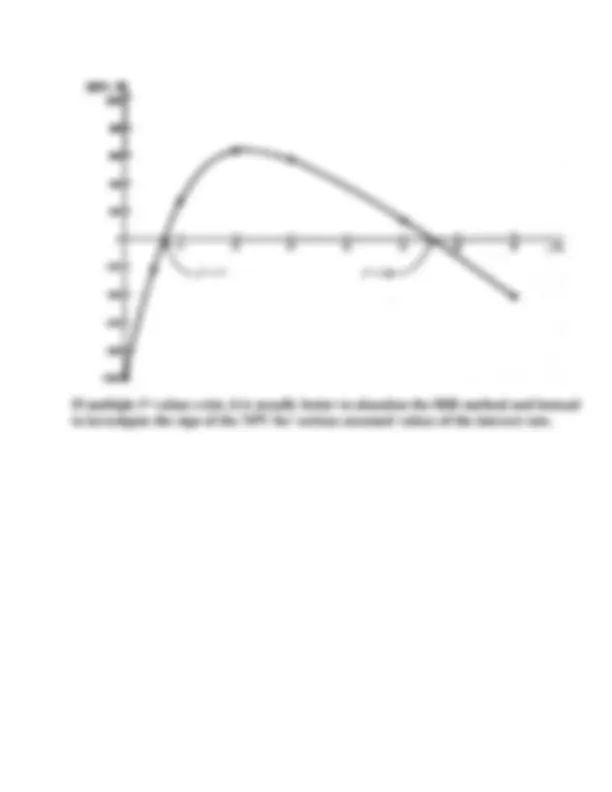
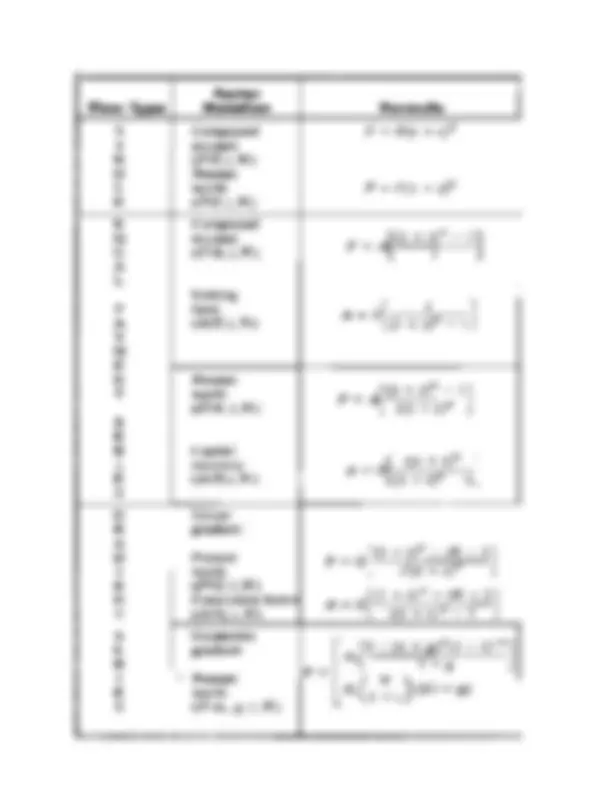
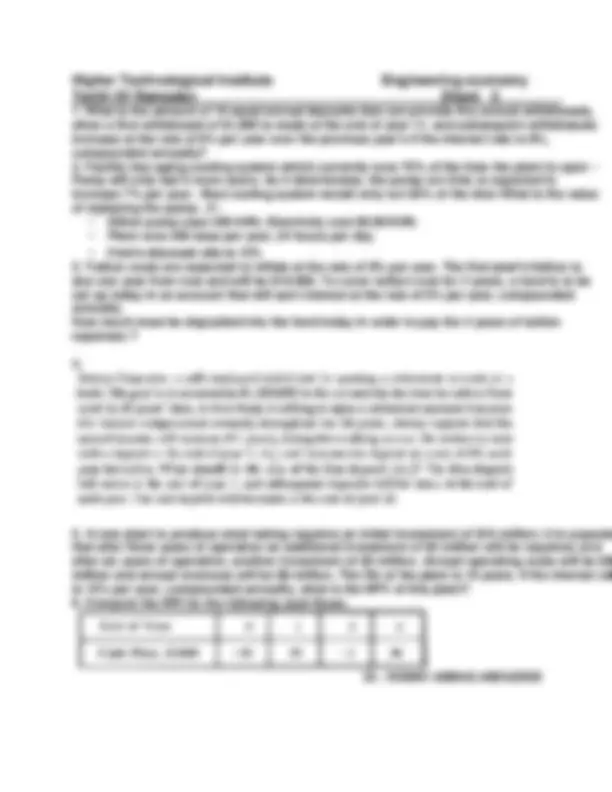
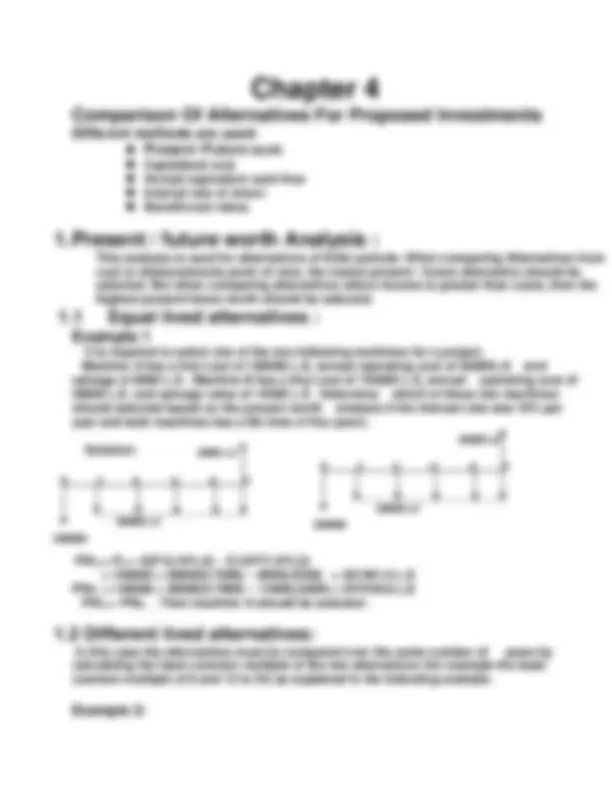

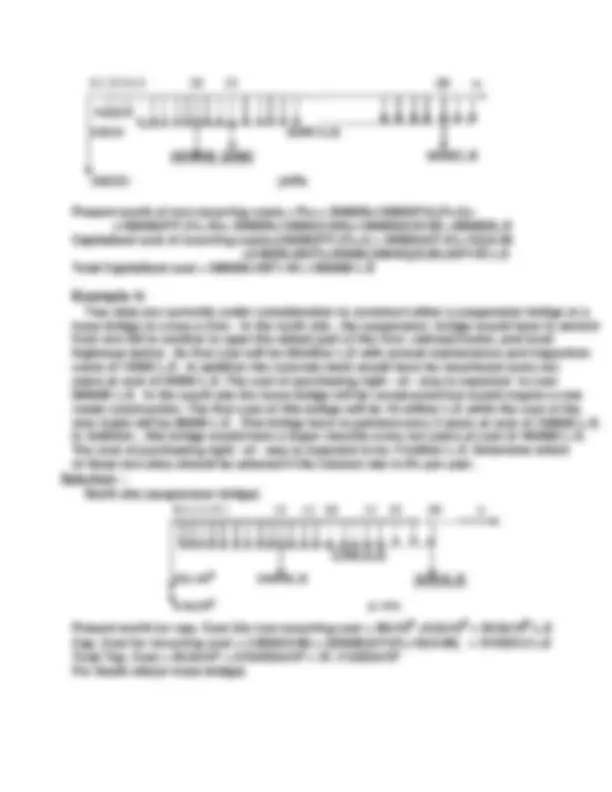
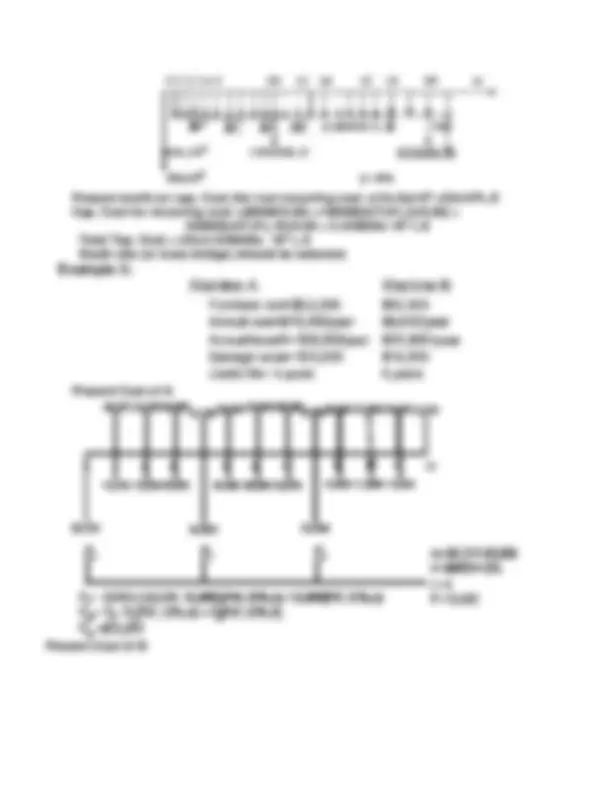
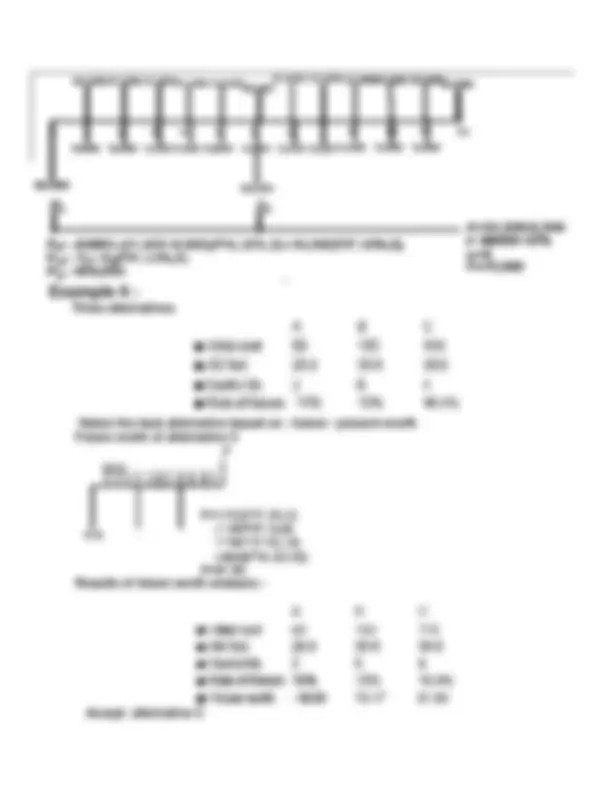
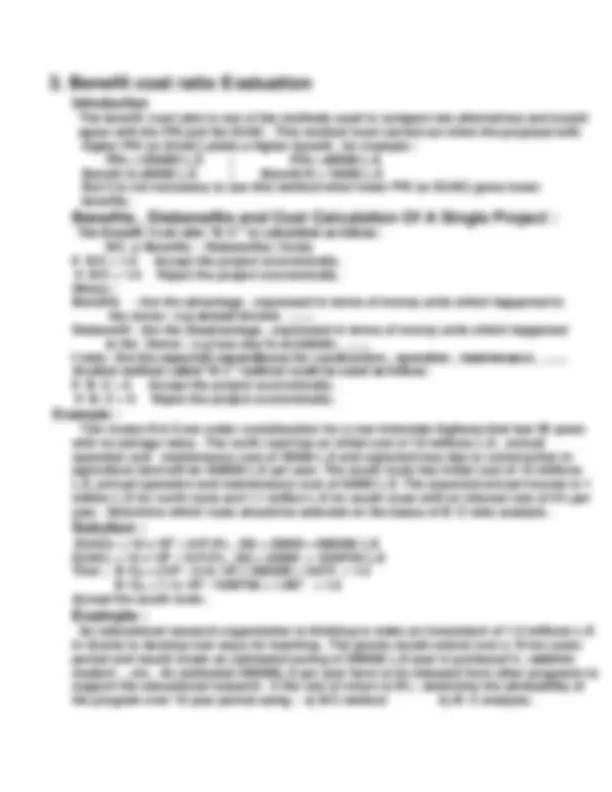
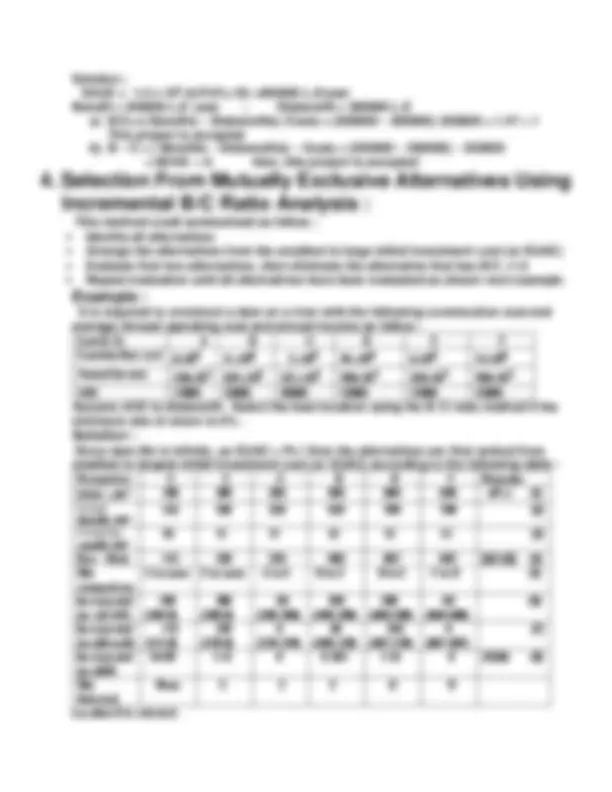
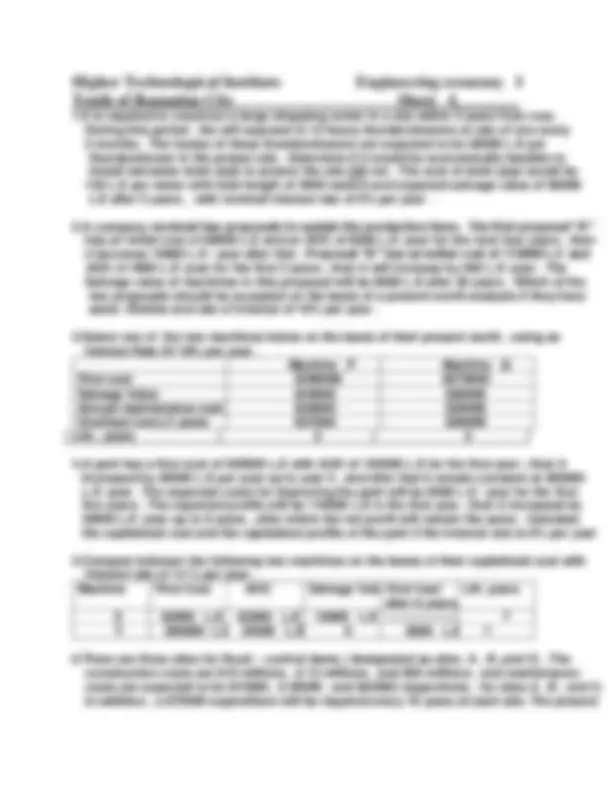
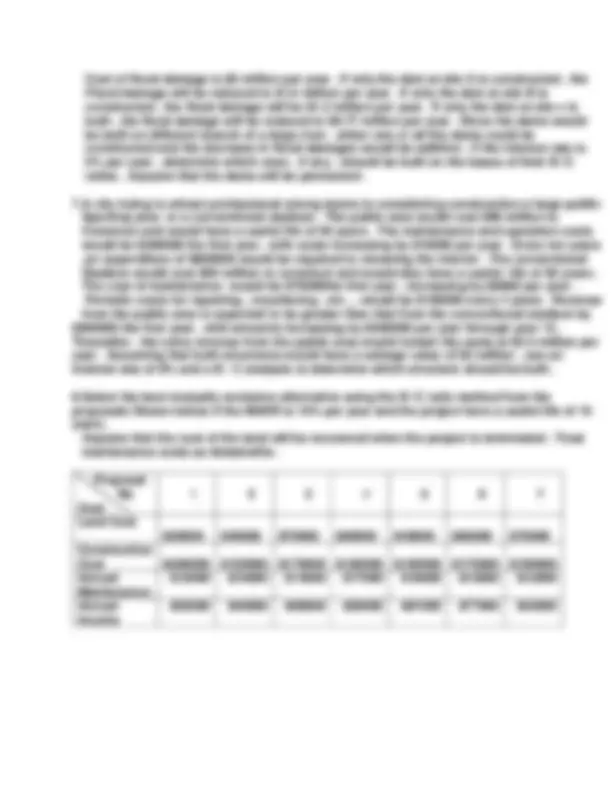
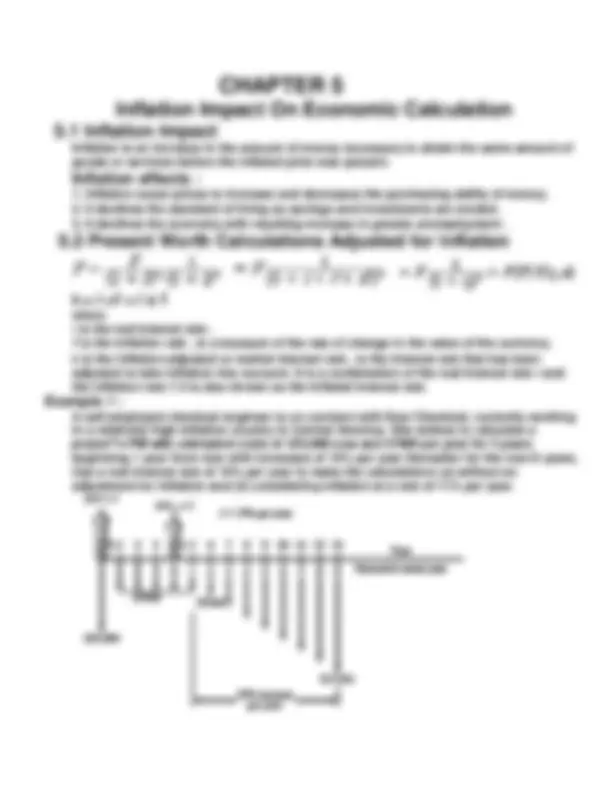
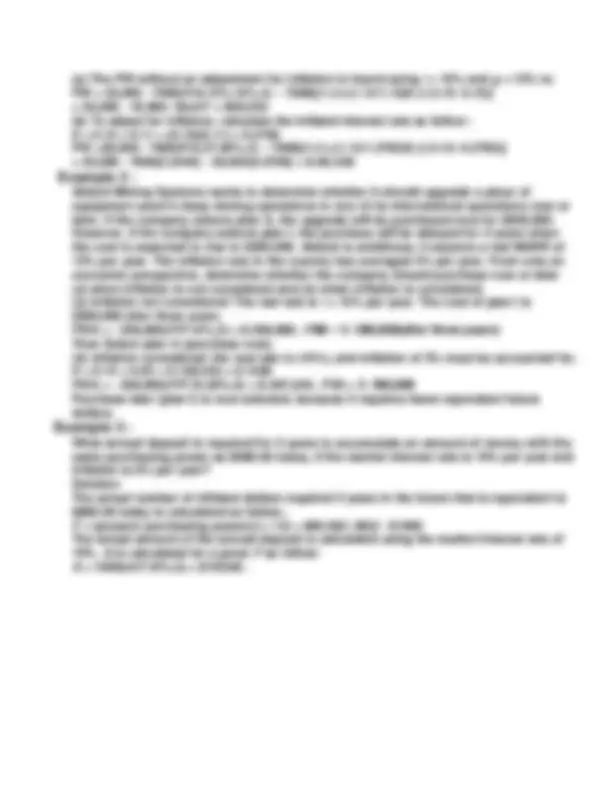
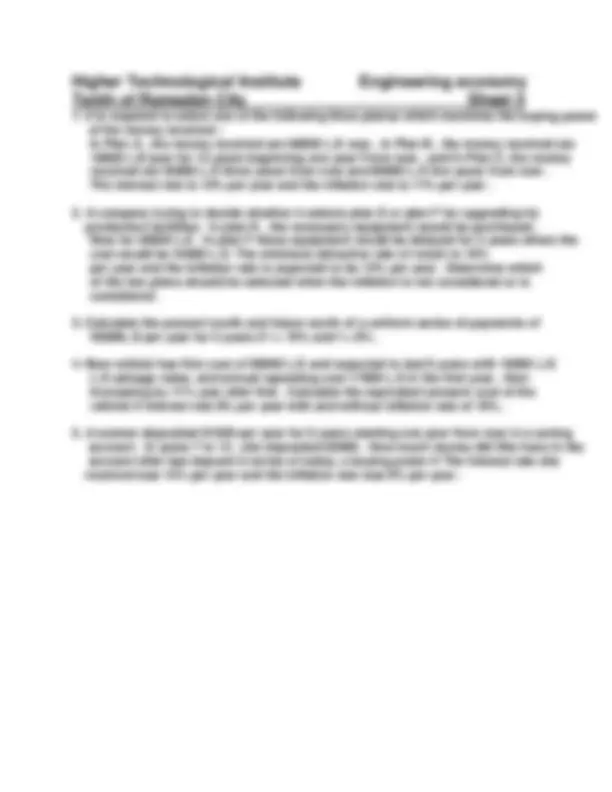
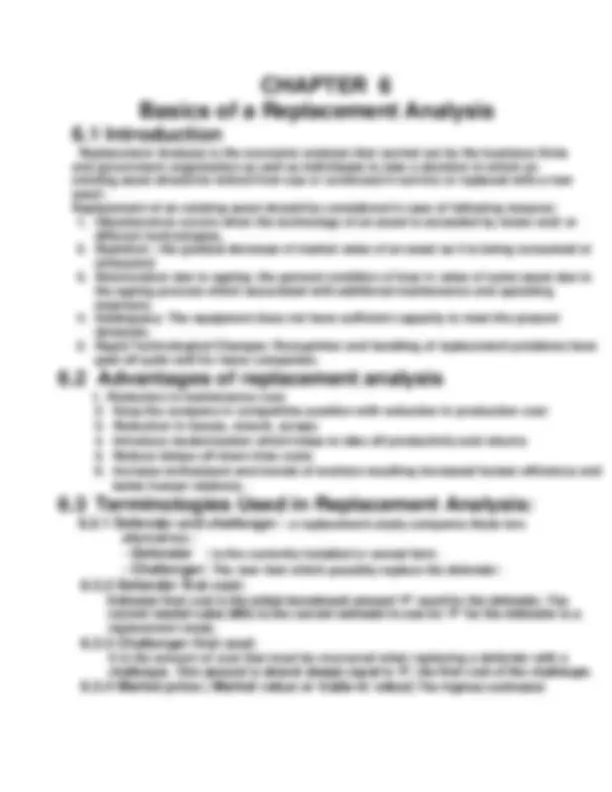


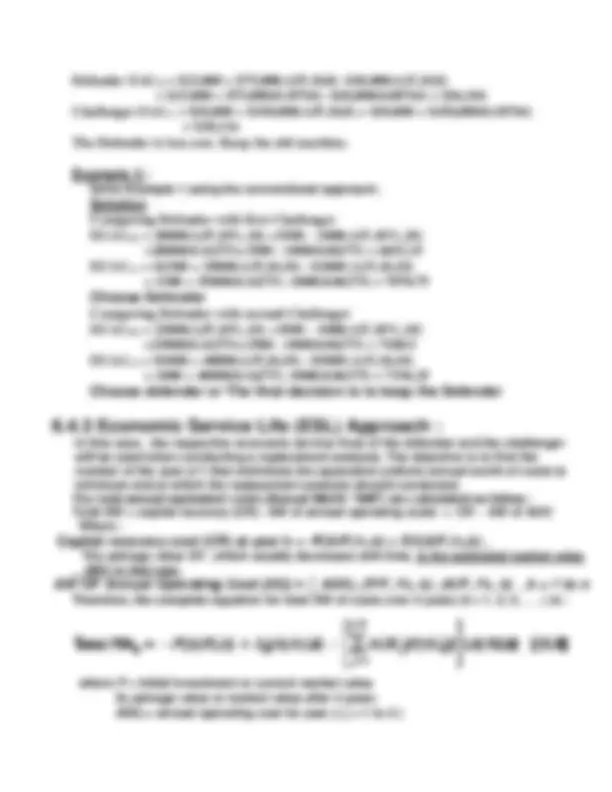
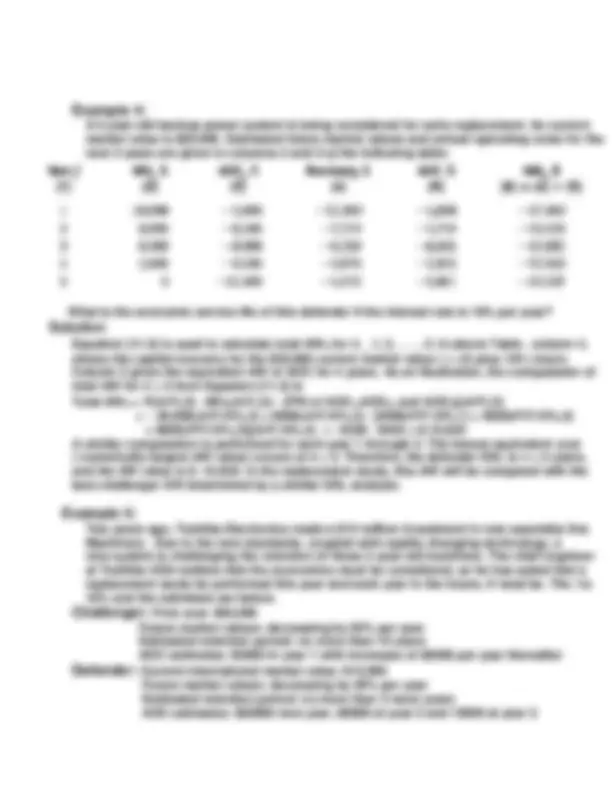
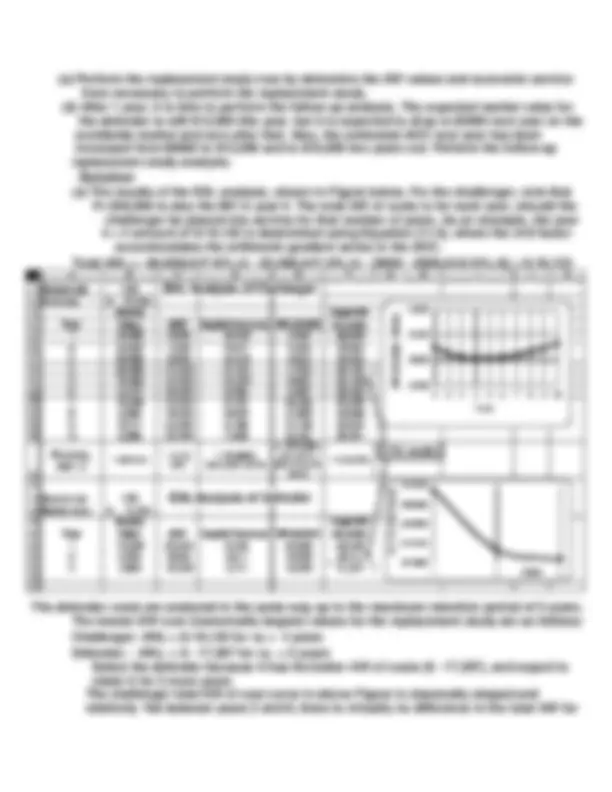
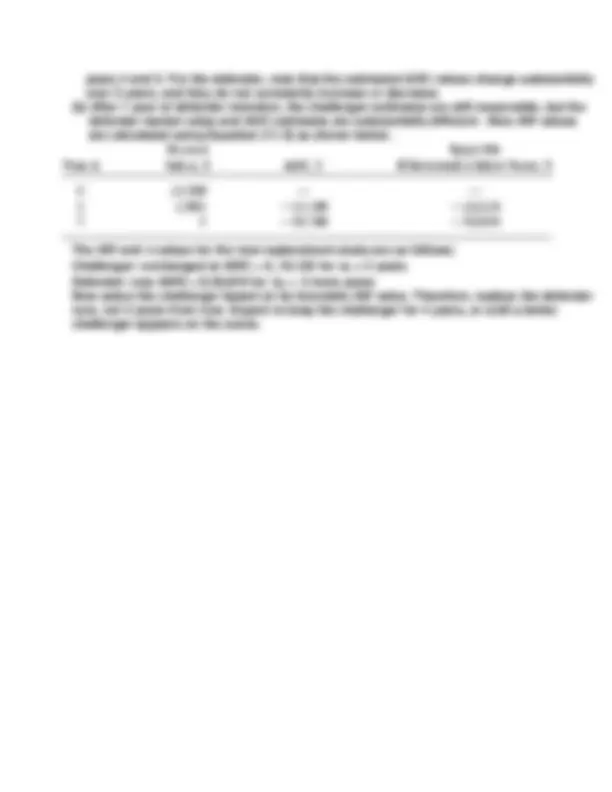
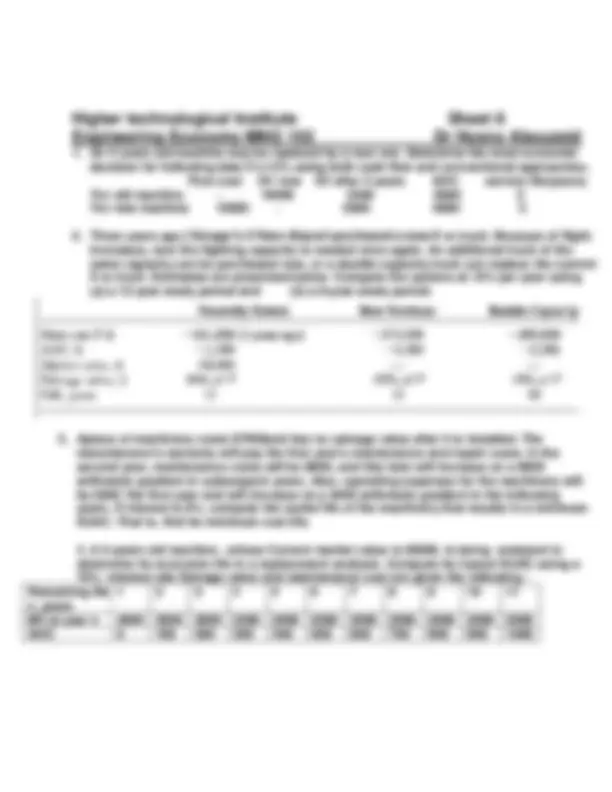
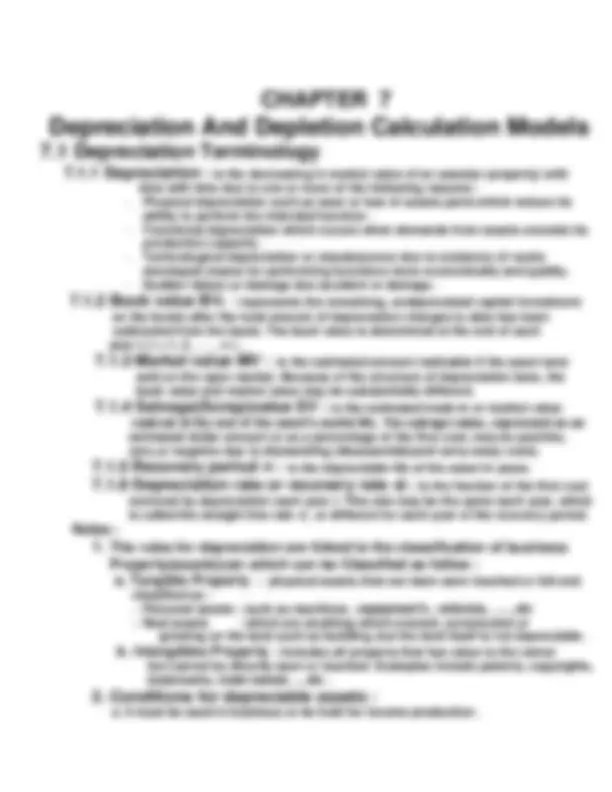
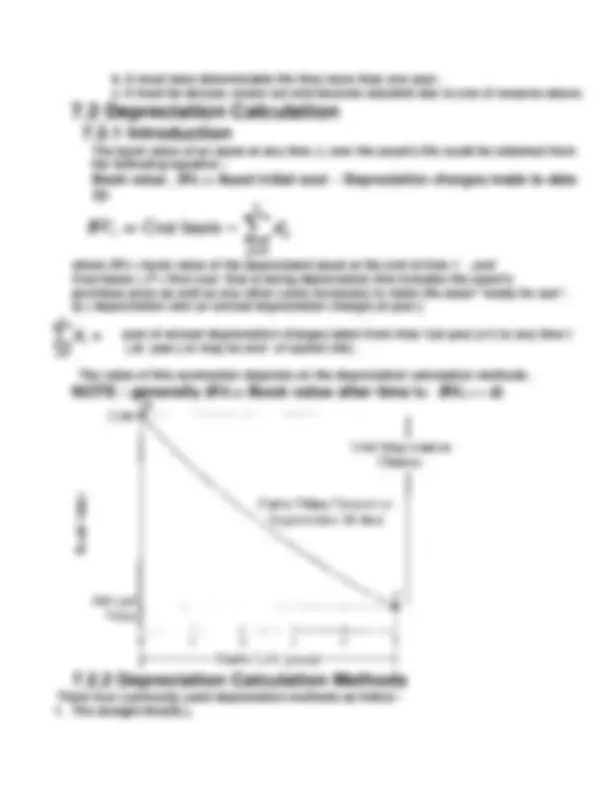
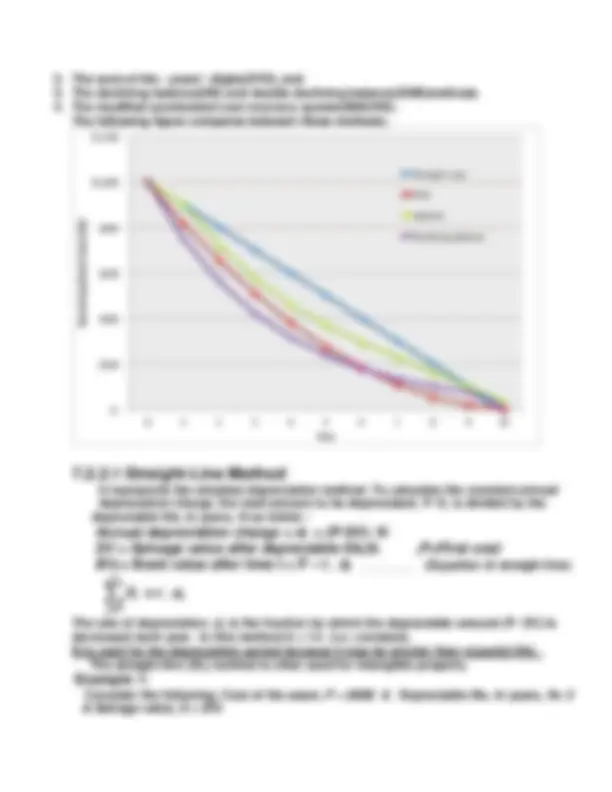
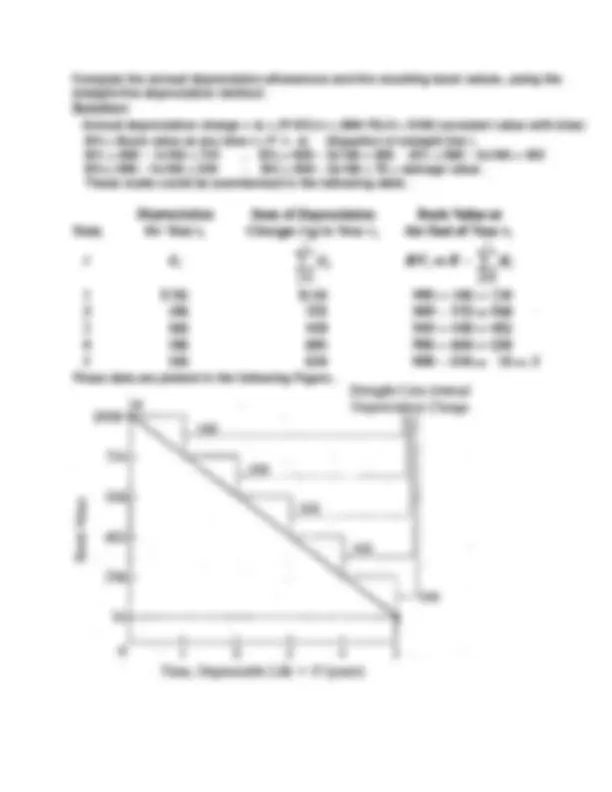
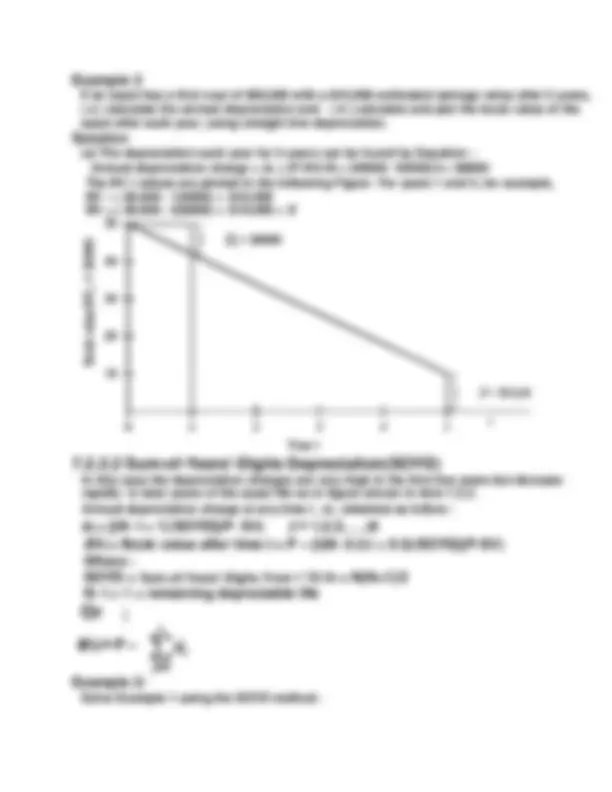
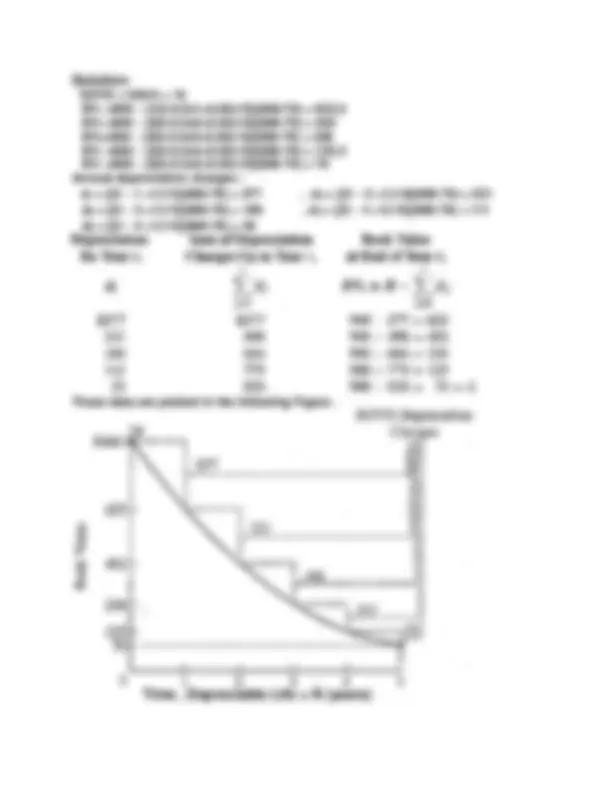
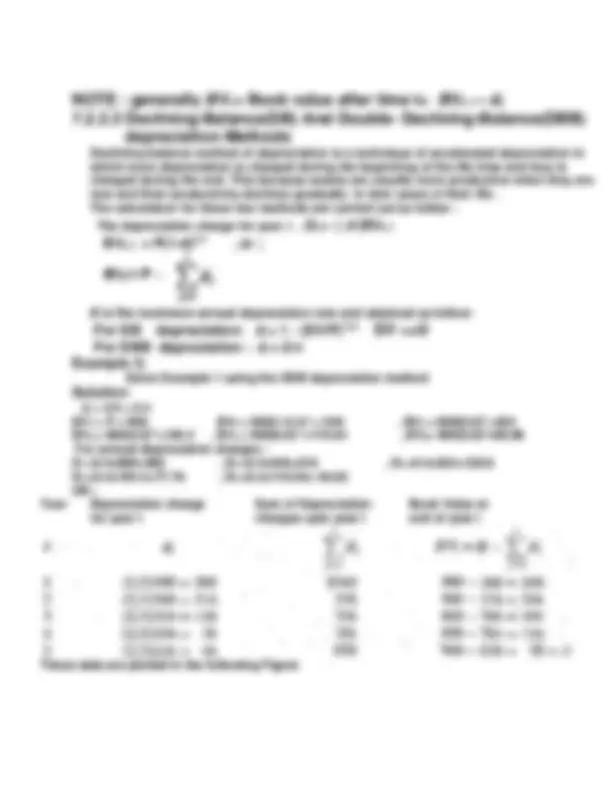
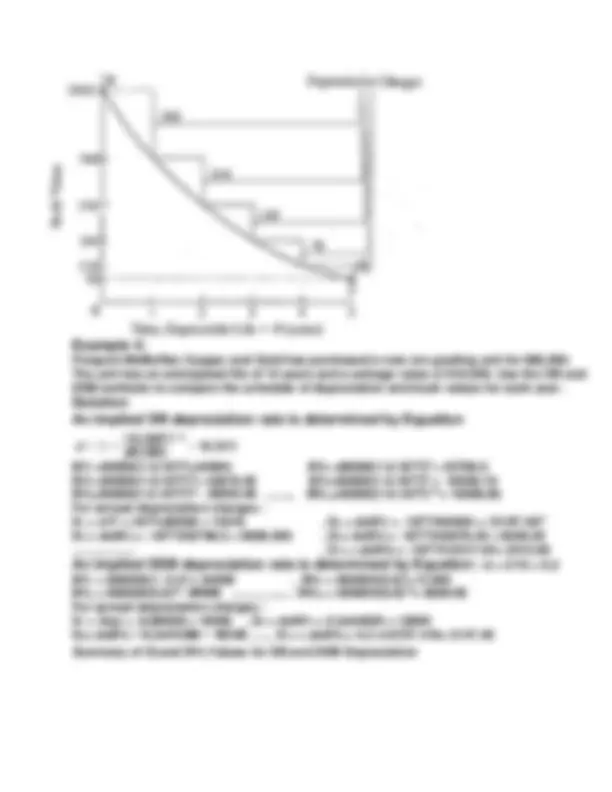
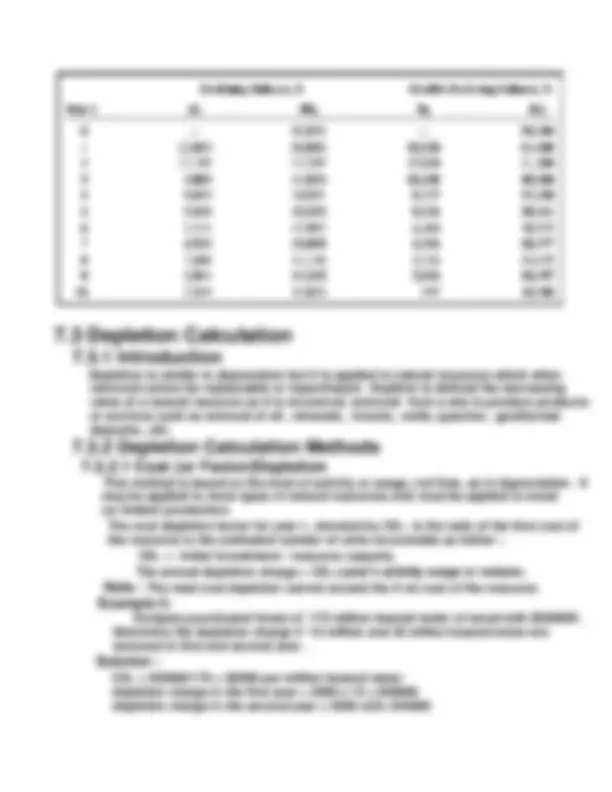
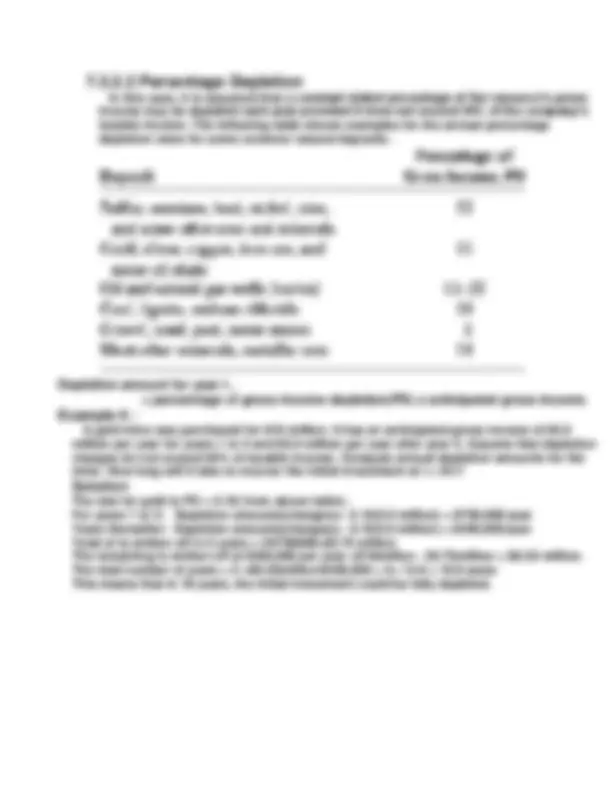
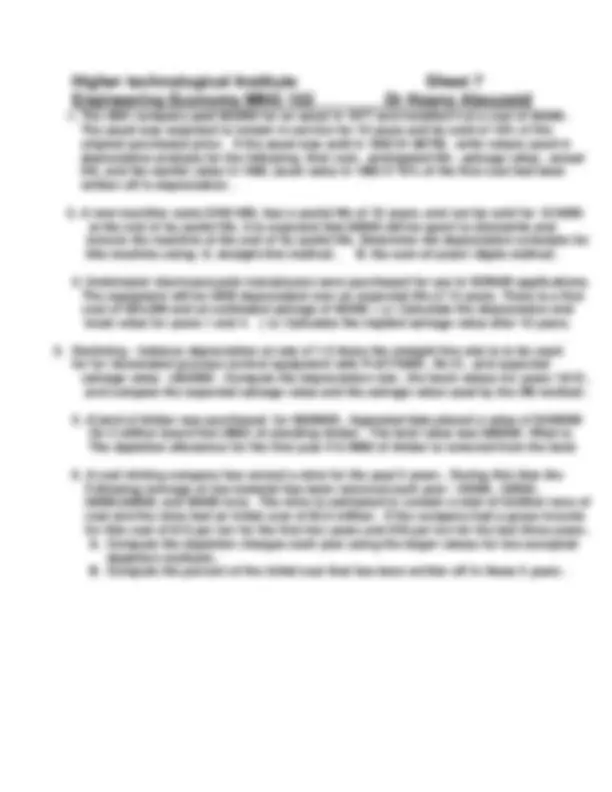
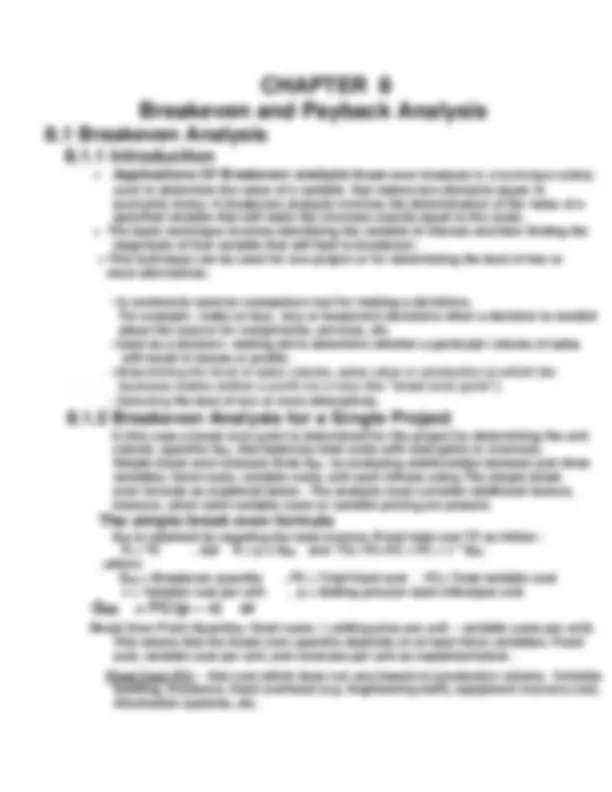
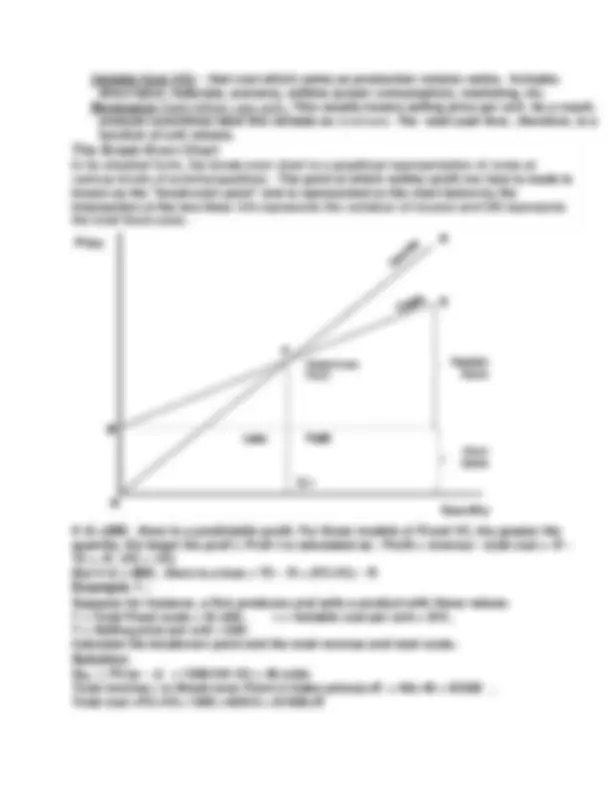
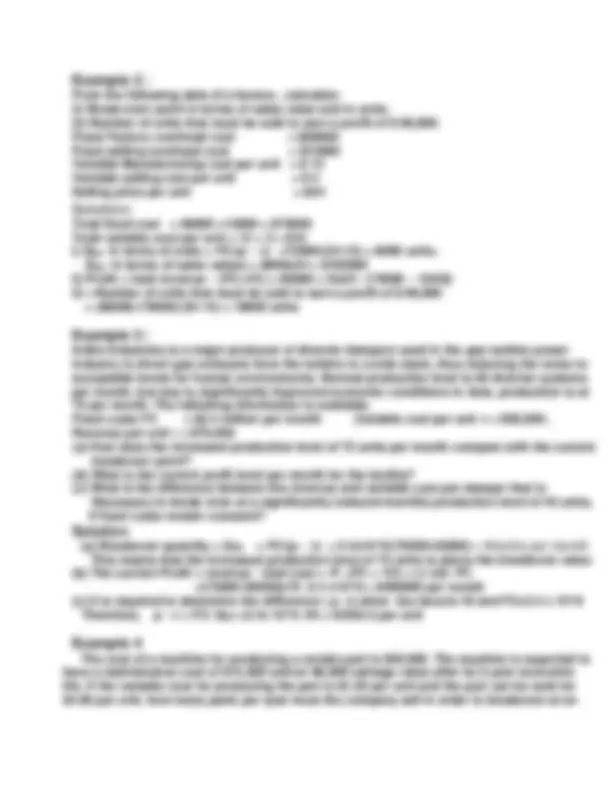
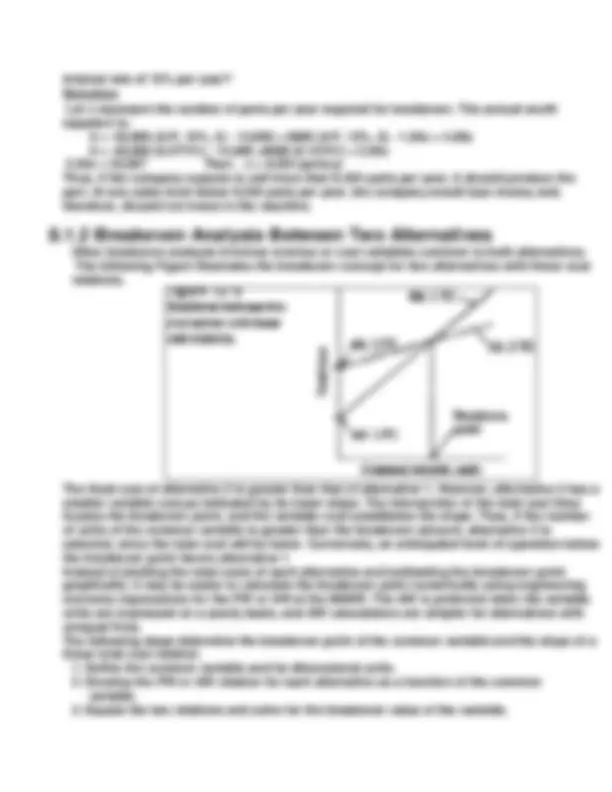
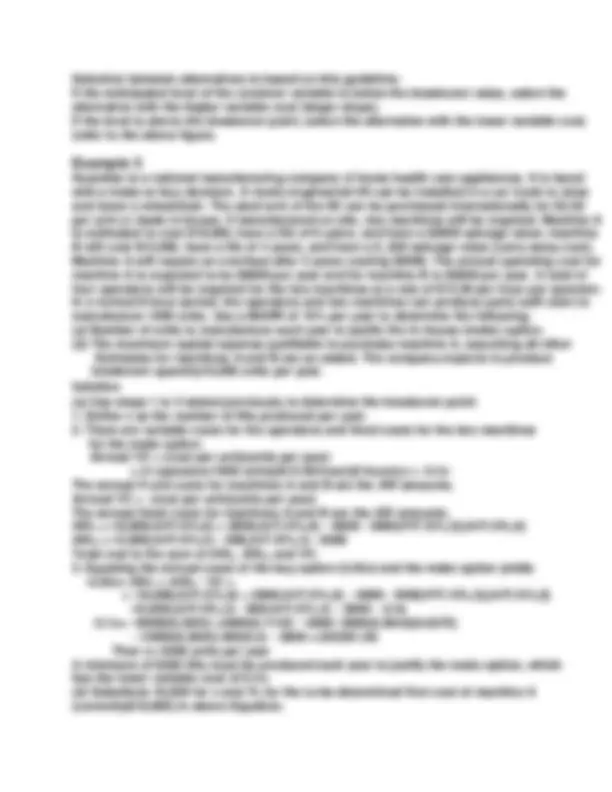
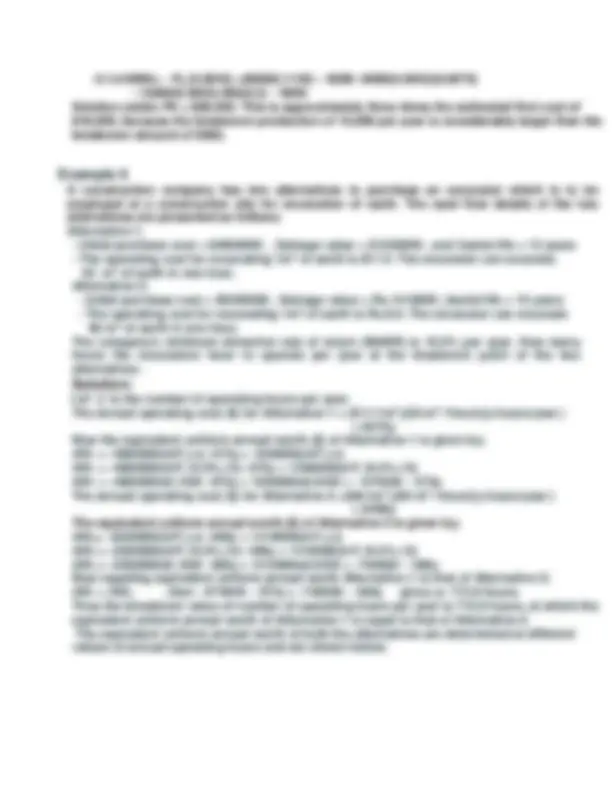
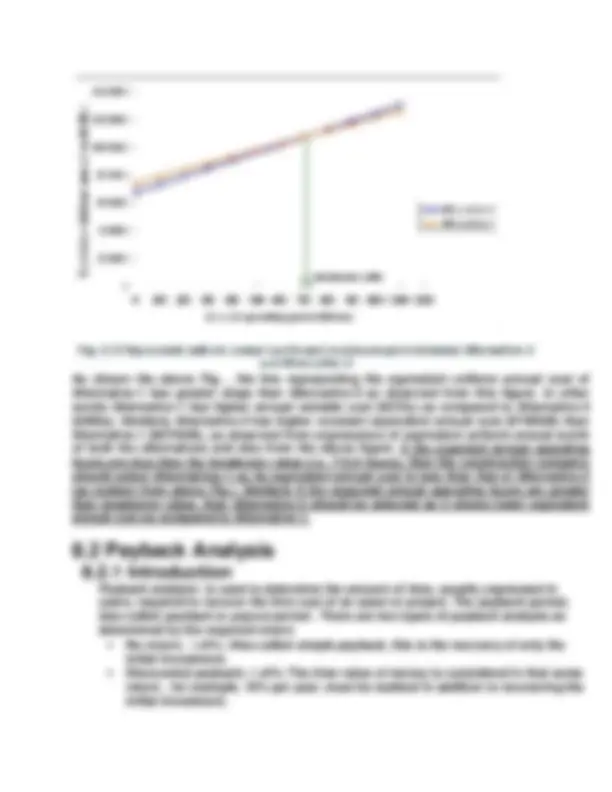
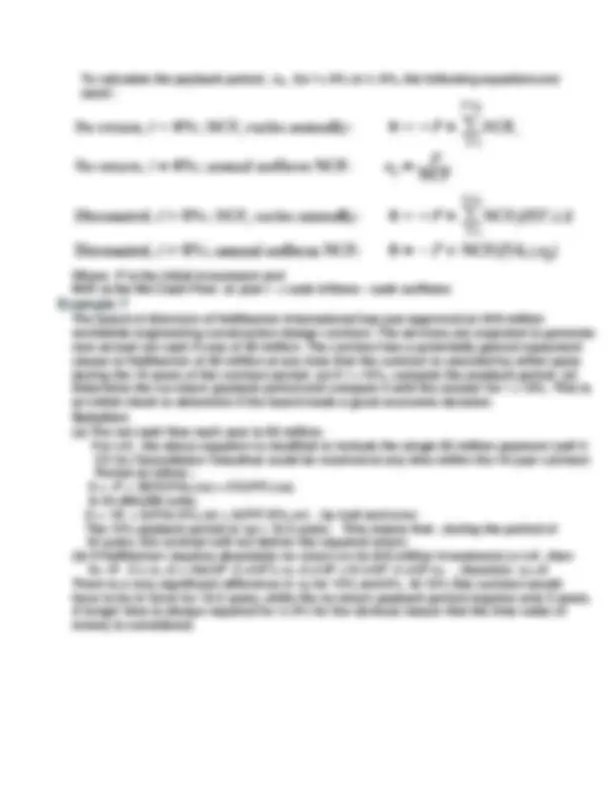
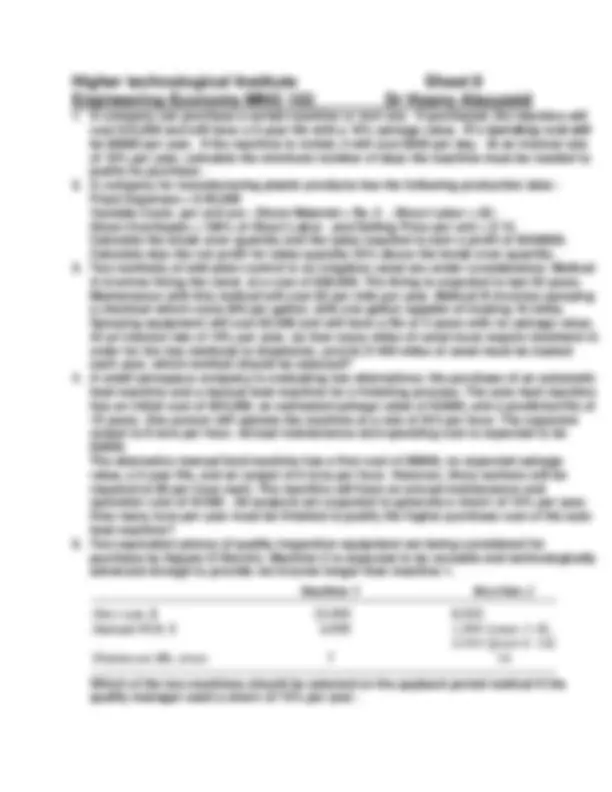
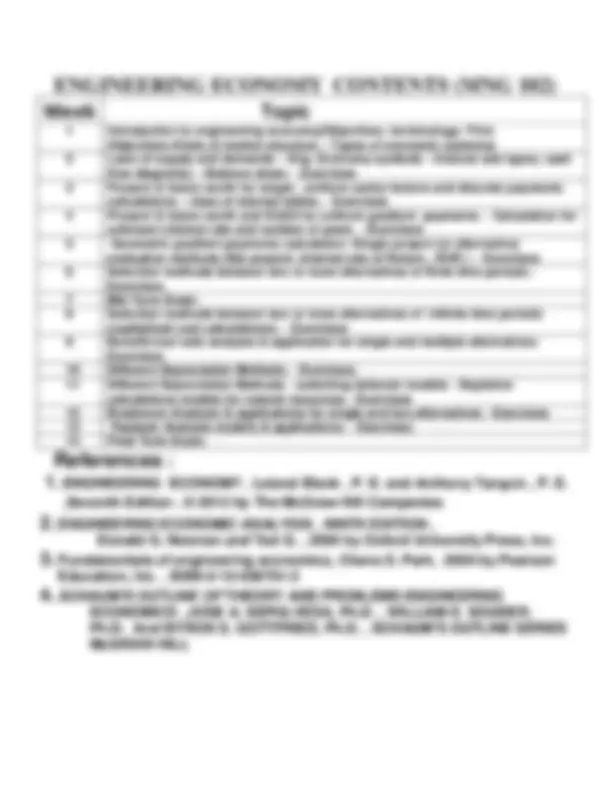
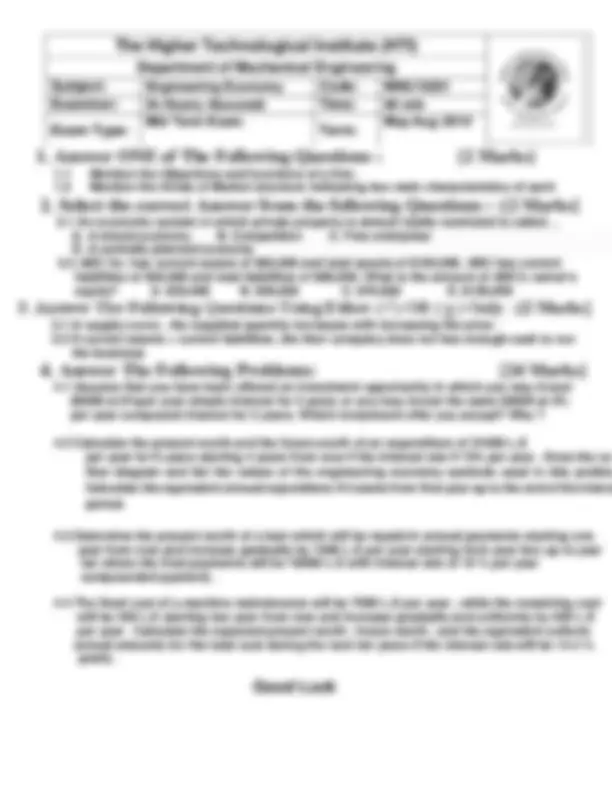
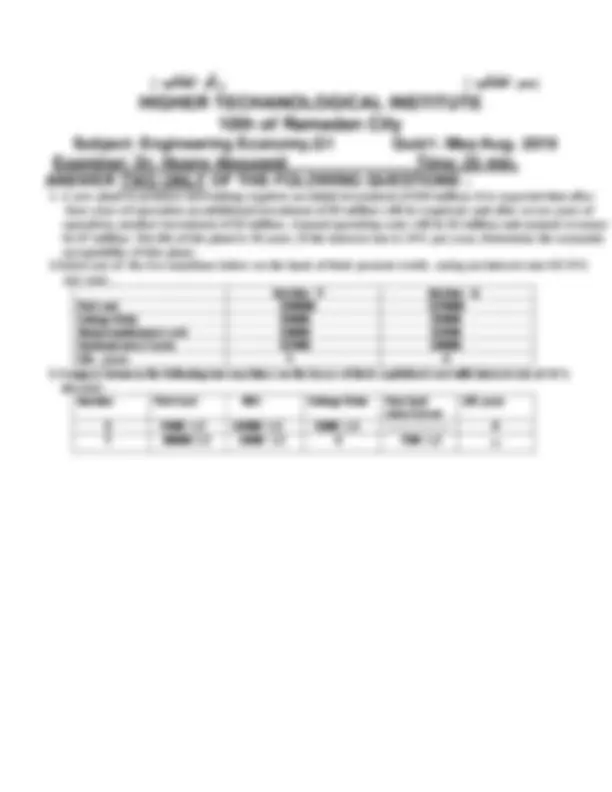
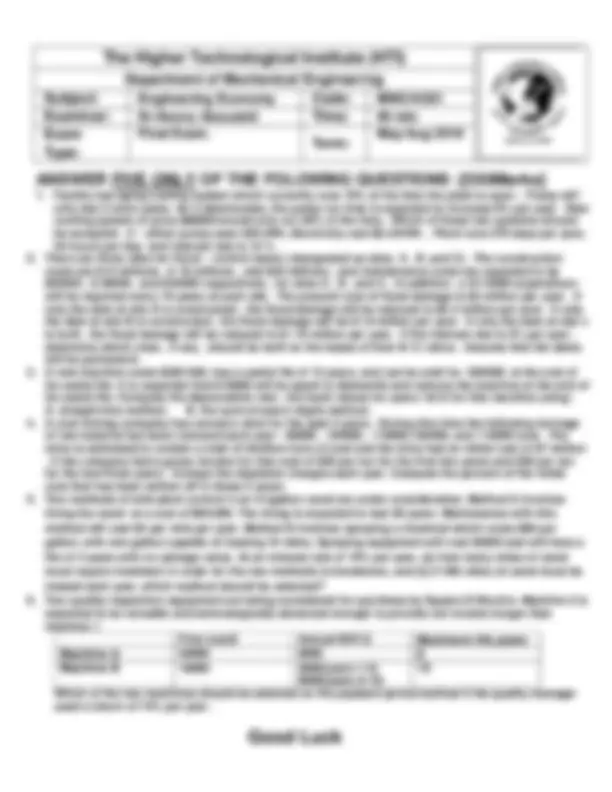
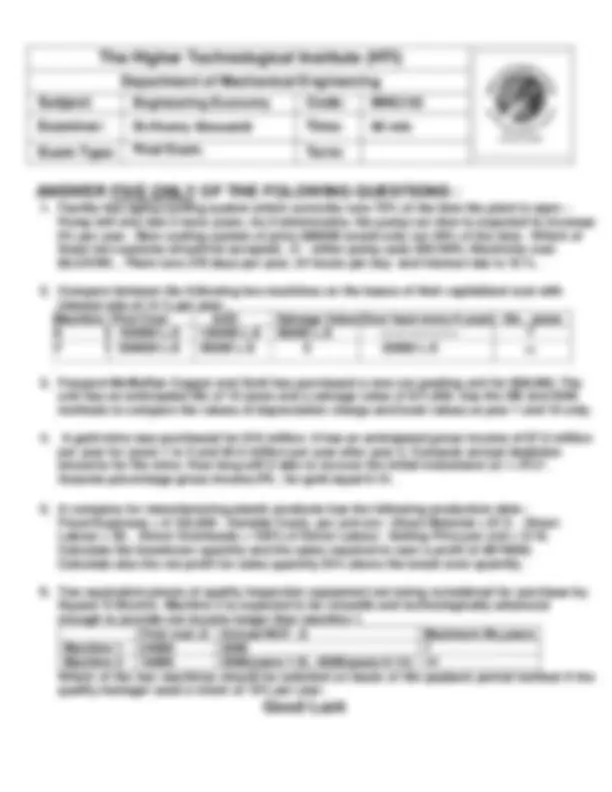


Study with the several resources on Docsity

Earn points by helping other students or get them with a premium plan


Prepare for your exams
Study with the several resources on Docsity

Earn points to download
Earn points by helping other students or get them with a premium plan
Community
Ask the community for help and clear up your study doubts
Discover the best universities in your country according to Docsity users
Free resources
Download our free guides on studying techniques, anxiety management strategies, and thesis advice from Docsity tutors
Sample problems with solution amd formula
Typology: Exercises
1 / 90

This page cannot be seen from the preview
Don't miss anything!




















































































On special offer
1.1 Introduction to engineering economy(Objectives - terminology- Firm
Objectives-Kinds of market structure – Types of economic systems)
1.2 Laws of supply and demands – Balance sheet- Eng. Economy symbols - interest rate
types, cash flow diagrams) – - Exercises
1.3 Sheet 1
2.1 Present & future worth for single , uniform series factors ,and discrete payments
calculations – Uses of interest tables - Exercises
2.2 Present & future worth and EUAS for uniform gradient payments - Exercises
2.3 Calculation for unknown interest rate and number of years - Exercises
2.4 Solved problems – Sheet 2
3.1 Present /Future Worth calculation for Geometric Gradient payments
3.2 Single Project Evaluation Methods : Net Present Value – Internal Rate Of Return
3.3 Sheet 3
time periods (present / future worth calculation methods)- Exercises.
4.2 Selection methods between different alternatives of infinite time periods
(capitalized cost ,and benefit/ cost ratio calculations methods) - Exercises
4.3 Sheet 4
5. CHAPTER 5 :Inflation Impact On Economic Calculation
5.1 Inflation Impact and Effects
5.2 Present/Future Worth Calculation Adjusted for Inflation- Exercises
5.3 Sheet 5
6.1 Introduction(Advantages &Terminologies Used of replacement analysis)
6.2 Different Approaches for comparing Defender and Challenger.
6.3 Sheet 5
7. CHAPTER 7 : Depreciation And Depletion Calculation Models
7.1 Different Depreciation Methods - switching between models- Exercises
7.2 Depletion calculations models for natural resources- Exercises
7.3 Sheet 7
8. CHAPTER 8 :Breakeven & Payback Analysis
8.1 Breakeven Analysis & applications for single and two alternatives – Exercises
8.2 Payback Analysis models & applications - Exercises
8.3 Sheet 8
become (1.1) of its original value after one year. TVM calculations can be used to
compare between different alternatives as will be explained later.
Is a measure of increase between the original sum borrowed or invested and the final
amount owed or accrued as follow:
a. For invested money :
Interest = total amount accumulated – original investment
b. For borrowed money :
Interest = Present amount owed – original loan
Defined as the ratio between the interest accrued per unit time and the original amount
expressed as percentage. In case of borrowed money , this value is called “Interest Rate”
while in case of invested money is called “ Rate of Return(ROR)”. Both value s are calculated
as follow:
Interest rate % = Interest accrued per unit time X 100% / original amount
A company borrowed $100000 and repaid 110000 after one year , compute
the interest and the interest rate?
Interest =110000-10000 = 100000 $ , Interest rate = 100000x100%/100000 =10 %
A company invested $100000 for one year at 15% interest. Compute the interest
gain and the amount accumulated.
Interest = 0 .15 X 100000 = $ 15000
Total amount accumulated = 100000 + 15000 = $ 115000
1.4 The Firm
1.4.1 Definition :
A firm is an organization that employs resources to produce and sell goods and
Services using suitable technology.
1.4.2 Firm Objectives
goods and services.
levels in a short period of time.
1.5 Types of Economic systems
E conomic Defined as is the social science that analyzes the production, distribution, and
consumption of goods and services.
The type of economy is determined by the extent of government involvement in
economic decision making. Therefore , there are 4 types of systems as follow :
1.5.1 Traditional Economic System
generation to another).
economic mechanisms in this type.
Examples: parts of Africa, parts of India, the original people of Australian, Eskimos
1.5.2 Command (
Communism) Economy
and distribute resources.
everyone!
individuals do.
Example: Vietnam, North Korea, Former Soviet Union.
And very little unemployment.
1.5.3 Capitalism/Market (or Free Market Economy Capitalism)
1.6.4 Oligopoly is a market structure in which :
firms.
Comparison between Different kinds of Market Structure
Perfect competition Large Homogeneous Non- existent Easy
Monopolistic
competition
Large Are close substitutes Non-
existent(low)
Easy
Oligopoly Few May be homogeneous
or close substitutes
Medium or high Difficult
Monopoly One Unique product Very high Impossible
1.7 Demand – Price Relationship
1.7.1 What is Demand?
willing to purchase at a specific price per unit of time, other factors (such as price of
related goods, income, advertising, etc) being constant.
1.7.2 The Law of Demand
The law of demand states that, if all other factors remain equal, the higher the price of
a good, the lower the quantity demanded from this good.
Demand curve is a graphical representation of price- quantity relationship. Individual
demand curve shows the highest price which an individual is willing to pay for
different quantities of the commodity.
Demand curve has a negative slope, i.e, it slopes downwards from left to right depicting
that with increase in price, quantity demanded falls and vice versa.
The factors affecting the downward sloping demand curve are :
consumer increases.
with other cheaper commodities.
consumer purchases more so as to equate the marginal utility and the price level.
1.8 Supply – Price Relationship
1.8.1 What is Supply?
Supply refers to the amount of a certain good producers are willing to supply when
receiving a certain price.
1.8.2 The Law of Supply
The law of supply states that the higher the price, the higher the quantity supplied. But
unlike the law of demand, the supply relationship shows an upward slope.
Supply curve is a graphical representation of price- quantity relationship. The supply curve o
a commodity usually slopes upward. In other words, an industry will offer to sell more
quantity of a good at a higher price than at a lower one.
A, B and C are points on the supply curve. Each point on the curve reflects a direct
correlation between quantities supplied (Q) and price (P). At point B, the quantity
supplied will be Q2 and the price will be P2, and so on.
Unlike the demand relationship, however, the supply relationship is a factor of time.
Time is important to supply because supplier takes time to adjust himself to a change in
the demand condition according to the nature of technical conditions of production.
1.9.2.1 Assets
It includes all resources owned by or owed to the firm or company and have two main
classes of assets : Current assets and fixed assets (sometimes called non-current or
long-term assets)
Represent shorter-lived working capital (cash, accounts receivable, etc.), which is
goods and/or services, and they are not intended for sale.
1.9.2.2 Liabilities
Defined as all financial obligations or money that a firm owes to outside parties such as
debts, bills ( فواتير ) , loans, bonds( سندات ودائع, ) ,etc... Liabilities have two main classes :
Current Liabilities and non-Current Liabilities.
A.Current liabilities are those that are due within one year and are listed in
B.Non-Current liabilities :or Long-term liabilities are due at any point after
1.9.2.3. Shareholders' Equity
Defined as all the financial value of ownership or the money attributable to a business'
owners(or shareholders). It is also known as "net assets or net worth ," since it is
equivalent to w hat’s left of the company’s assets after paying off liabilities.
It includes Share capital , stocks issued and retained earning by a firm.
A. Share Capital
B. Retained Earnings
C. Preferred and common stocks سهم المفضلة والشائعةاأل
Common stock and preferred stock are the two main types of stocks that are sold by
companies and traded among investors on the open market. A preferred stock pay an
agreed-upon dividend at regular intervals. Common stocks may pay dividends depending
on how profitable the company is.
Example Of Balance Sheet For a Firm
1
= sum at end of year 1 = P(1+i) + 200 = 2000(1.1) +200 = 2400 L.E
2
= sum at end of year 2 = P 1
(1+ i ) + 200 = 2400(1.1)+200 = 2840 l..E
P3 = sum at end of year 3 = P 2 (1+ i ) + 200 = 2840(1.1) + 200 = 3324 L.E
P4= sum at end of year 4 = P 3 (1+ i ) + 200 = 3324 (1.1) + 200 = 3856.4 L.E
5 =
sum at end of year 5 = P 4
(1+ i ) + 200 = 3856.4(1.1) + 200 = 4444.04 L.E
Final sum at the end of the five years = 4444.04 L.E
Note:
1.11.3 Nominal , Effective Interest , and Effective annual Interest Rates
Many financial transactions require that interest be compounded often than once a
Year (e.g quarterly ,monthly , daily , etc..) In such situations ,there are three
Expressions for the interest rates as follow :
The nominal interest rate , r , is expressed on an annual basis.
The effective interest rate , ieff , is the rate that corresponding to the actual interest
Periods (m). Value of ieff is obtained dividing the nominal interest rate “r” by the
number interest periods per year “m” as follow :
ieff = r% / m (per Compounding period m).
m
A bank claims to pay interest to its depositors at rate of 6% per year compounded
quarterly. What are the nominal , effective interest rates and the effective annual
interest rates?
The nominal interest rates is r = 6% .since there are four interest periods per year (m)
then the effective interest rate is :
ieff =6%/4 = 1.5 % per quarter or quarterly.
The effective annual interest rate , ieffa , obtained as follow :
ieffa = (1 + r/m)m - 1= (1+.06/4)4 - 1 = .06136 = 6.136 %
Three different bank loan rates for electric generation equipment are listed below :
Determine the effective rate on the basis of the compounding period for each rate.
(a) 9% per year , compounded quarterly (b) 9% per year , compounded monthly
(c) 4.5 % per 6 months , compounded weekly.
Apply the equation ieff = r% / m to determine the effective rate per compounding
period (cp) for different compounding periods as shown in the following table :
1.12 Cash Flow Diagram :
The cash flow defined as the flow of receipts (income) and cash disbursement
(costs) which occur over a given time interval.
The cash flow diagram is simply a graphical representation of cash flows drawn
on a time scale as shown.
period. End of period means one time period from date of transaction.
“– “represents disbursements.
A person deposited 10000 L.E now into his account which pays 10% per year. He plans
withdraw an equal end of year amount of 2000 L.E for 5 years starting next year and closing
account by with drawing the remaining money at the of sixth year. Construct the cash f
diagram. Find the amount of exit in each of end interest periods and the remaining sum.
Solved Problems
1.1 The ABC Company deposited $100 000 in a bank account on June 15 and withdrew a
total of $115 000 exactly one year later. Compute: (a) the interest which the ABC Company
received from the $100 000 investment, and (b) the annual interest rate which the ABC
Company was paid.
1.3 Compare the interest earned from an investment of $1000 for 15 years at 10% per year
simple interest, with the amount of interest that could be earned if these funds were
invested for 15 years at 10°/o per year, compounded annually.
The simple interest is given by I = (15)(0.10)($10 00 = ) $
Compound interest = F-P = P(1+ i)
n
15
= $3177.25 or more than double the amount earned using simple interest.
1.4 How it would take for an investor to double his money at 10% per year compounded annually?
Actually, since the interest is compounded only at the end of each year, the investor
would have to wait 8 years.
1.5 Suppose that a man lends $1000 for four years at 12% per year simple interest. At the end of the
four years, he invests the entire amount which he then has for 10 years at 8% interest per year,
compounded annually. How much money will he have at the end of the 14-year period?
F = P(1+ n 1
x i l
)(l+ i 2
n
10
1.6 Suppose that the interest rate is 10% per year, compounded annually. What is the minimum
amount of money that would have to be invested for a two-year period in order to earn $300 in
interest?
Higher Technological Institute Engineering economy MNG
Tenth Of Ramadan Sheet 1 _________
I. Answer The Following Questions :
1.1 Mention the Objectives and functions of a firm.
1.2 Mention the Types of Economic systems indicating for each one two of the following
terms: main characteristics - Examples - Advantage – disadvantages.
1.3 Mention the Kinds of Market structure indicating two main characteristics of each
,
s structure using a suitable diagram.
1.7 Calculate the principle and the present value of a sum that has been deposited three years
ago to become 12000 L.E after one year from now in both cases of simple and compound
interest of 12 % per year. Calculate also the interest.
1.8 If you invest 10000 L.E now in a business venture that promises to return 14641 L.E, how
many years required to receive this return in order to make interest rat of 10 % per year
compounded yearly. On your investment?
1.9 Assume that you have been offered an investment opportunity in which you may invest $
at 7%per year simple interest for 3 years or you may invest the same $1000 at 6% per year
compound interest for 3 years. Which investment offer you accept?
1.10 Sales revenues for a lift – truck product line are estimated to be 500,000 L.E in the first year,
then decrease by 40000 L.E per year up to year 5 at interest rate of 15 % per year. Draw the
cash flow diagram, and then calculate the future worth at the end of year five.
1.11 As a result of an old loan for a bank, there remain 5 equal payments each of 10000 L.E with
interest rate of 8 % per year. The house just been sold to a new owner, who wishes to
renegotiate the loan to reduce the annual payments by increasing it’s number t o ten instead
of five years. The bank agree but with interest rate of 10 % per year. Calculate the amount of
the new annual payments and the total amounts of money received by the bank in both cases.
1.12 The costs of production in a factory is 86120 L.E in the first year , 97100 L.E in the
second year and 105630 L.E in the fourth year with interest rate of 14% per year. A tooling
investment of 12000 L.E is carried out now to reduce all production costs by 12% per year.
Calculate the present worth before and after carrying out the tooling investment. If this
investment is delayed for one year from now; Calculate the present worth of the cost of delay.
Draw the cash flow diagrams in all cases.
1.13 Calculate the present worth and the future worth of an expenditure of 17000 L.E per year for
6 years starting 3 years from now if the interest rate if 15% per year. Draw the cash flow
diagram and list the values of the engineering economy symbols used in this problem.
Calculate the equivalent annual expenditure if it starts from first year up to the end of the
interest period.
1.14 Suppose that a person invests $3000 at 10% per year, compounded annually, for
a. Market economy b. Command economy…….
C. traditional economy d. Mixed economy
2.1 5 Which of the following is an economic system in which the government and
individuals are used to decide how to use scarce resources?
a. Market economy b. Command economy
c. traditional economy d. Mixed economy…….
2.1 6 Type of economy that is based on trading and bartering?
a. Socialist b. Traditional c. Free Enterprise d. Command
2.1 7 An economic system in which private property is almost totally restricted is called ...
A. A mixed economy B. Competition C. Free enterprise
D. A centrally planned economy
III. Answer The Following Questions Using Either (√ ) OR ( χ ) Only:
3.1 Market structure refers to the competitive environment in which the buyers and
sellers of a product operate… T
3.2 A market is defined as a place where buyers go to purchase units of a commo dity …..F
3.3 Oligopoly refers to a type of market organization that is characterized by large number of
firms selling a differentiated commodity….F
3.4 Monopolistic competition is a form of market organization that combines elements of
perfect competition and monopoly……T
3.5 Monopoly is a market structure in which there is only one buyer of a product for which
there are no close substitutes….F
3.6 Oligopoly is a market structure in which there are few sellers of a product and additional
s ellers cannot easily enter the industry T…...
3.7 The demand curve shows that the demanded quantity increases with increasing the price ….F
3.8 In supply curve , the supplied quantity increases with increasing the price
3.9 The demand curve shows that the demanded quantity increases with increasing the price….F
3.10 A price ceiling imposed above the market equilibrium price will result in a shortage of the
product…. F
3.11The law of demand refers to the relationship between consumer income and the quantity
of a commodity demanded per time period…F
3.12 The substitution effect holds that an increase in the price of a commodity will cause an
individual to search for substitutes….T
3.13 The income effect holds that a decrease in the price of a commodity is, some respects, the
same as an increase in income….T
3.14 The balance sheet heading will specify a Period Of Time…..F
3.15 The balance sheet heading will specify a Point Of Time…..T
3.16 Repaid expenses are considered as one of current liabilities in the balance sheet….F
3.17 Fixed assets are considered as one of current assets in the balance sheet. …… F
3.19 Customer prepayments are considered as one of current liabilities in the balance sheet….T
3.20 Pension fund liabilities are considered as one of current liabilities in the balance sheet…..F
3.21 If current assets > current liabilities ,the then company does not has enough cash to run
the business…..F
Dr HOSNY ABBAS ABOUZEID
0 1 2 3 n- 1 n
P? i= …. %
CHAPTER 2
SINGLE PAYMENT FACTORS
2.1 Introduction
The aim of this chapter is to derive a formula for the following engineering economy
factors:
2.2 Derivation of Single – Payment formulas Factors: Compound Amount (
)
& present worth (
):
In this case , it is required to get the final value “F” , in terms of given values of a
single payment “P” with compound interest rate “ i” , and after time period “ n” , as
shown in the cash flow diagram.
Since F 1 = final sum at year 1=P +P*i , F 2 =F 1 +F 1 *i , P i= …%
Then F 2
= Final sum at end of year 2 = P*(𝟏 + 𝒊)
𝟐
, 0 1 2 n=… F 3
Final sum at end of year 3 =F 2
2
*i F?
= F 2 (1+i)= P*
𝟑
, So, Fn =Final sum at end of year n =P*
𝒏
=
( 𝟏 + 𝒊
)
=
𝒏
2.3 Derivation of Uniform – Series Present Worth Factor (
):
In this case, it is required to get the present worth value P in terms of known values Of
A, i, n as shown in the cash flow diagram.
P=P 1 +P 2 +P 3 +…..= P n
= Sum of all the present worth values
𝟐
𝒏
Multiply both sides by
we get :
= A[
𝟐
𝟑
𝒏
𝒏+𝟏
]
Then,
- P=A [
𝟐
𝟑
𝒏
𝒏+𝟏
− {
𝟐
𝟑
𝒏
}]